Leadership and Management Development Programme for ABC Company
VerifiedAdded on 2023/06/05
|34
|5249
|83
AI Summary
This report discusses the importance of adopting a leadership and management development programme for ABC Company. It covers the role of a leader and manager, their functions, differences, and qualities of a successful leader. Additionally, it explains operations management and its different approaches. The report also highlights the external factors affecting the operation management of ABC Company and the impact of these factors on decision making as a store manager.
Contribute Materials
Your contribution can guide someone’s learning journey. Share your
documents today.

Running head: management operations 1
A report on adopting a leadership and management development programme for ABC
Company
MANAGEMENT AND OPERATIONS
STUDENT
COURSE
UNIVERSITY
DATE
A report on adopting a leadership and management development programme for ABC
Company
MANAGEMENT AND OPERATIONS
STUDENT
COURSE
UNIVERSITY
DATE
Secure Best Marks with AI Grader
Need help grading? Try our AI Grader for instant feedback on your assignments.
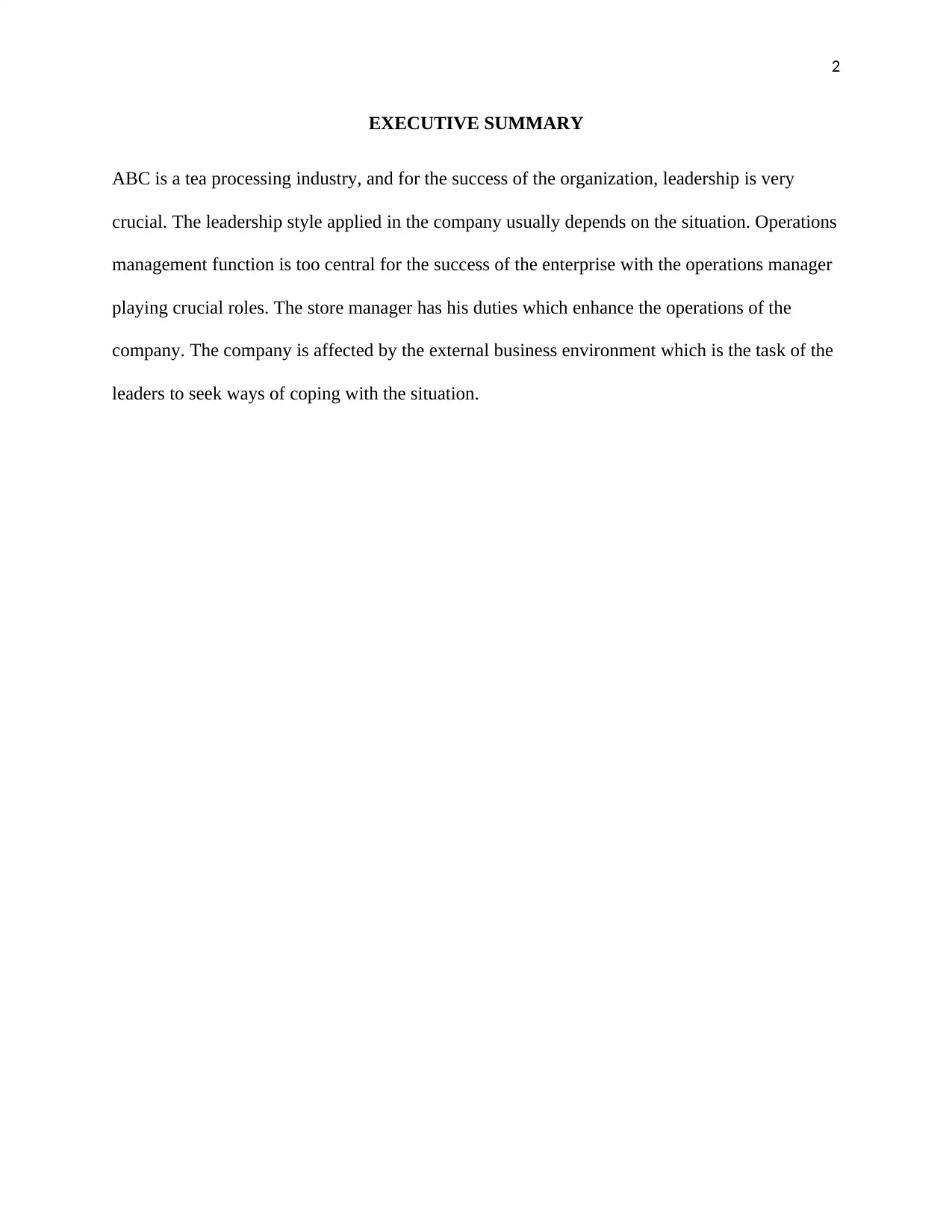
2
EXECUTIVE SUMMARY
ABC is a tea processing industry, and for the success of the organization, leadership is very
crucial. The leadership style applied in the company usually depends on the situation. Operations
management function is too central for the success of the enterprise with the operations manager
playing crucial roles. The store manager has his duties which enhance the operations of the
company. The company is affected by the external business environment which is the task of the
leaders to seek ways of coping with the situation.
EXECUTIVE SUMMARY
ABC is a tea processing industry, and for the success of the organization, leadership is very
crucial. The leadership style applied in the company usually depends on the situation. Operations
management function is too central for the success of the enterprise with the operations manager
playing crucial roles. The store manager has his duties which enhance the operations of the
company. The company is affected by the external business environment which is the task of the
leaders to seek ways of coping with the situation.

3
Table of Contents
Task 1.........................................................................................................................................................6
CONCEPT OF LEADERSHIP............................................................................................................6
The Role of a leader in the organization..................................................................................................7
He is a guide...........................................................................................................................................7
Formulation of strategies......................................................................................................................7
Evaluates performance..........................................................................................................................8
He is a philosopher................................................................................................................................8
LEADERSHIP CHALLENGES...............................................................................................................8
QUALITIES OF A SUCCESSFUL LEADER.........................................................................................9
BE FOCUSED........................................................................................................................................9
HAVE CONFIDENCE..............................................................................................................................9
BE OPEN AND TRANSPARENT...........................................................................................................9
HIGH DEGREE OF INTEGRITY..........................................................................................................9
BE INNOVATIVE...................................................................................................................................10
PERSISTENCE.......................................................................................................................................10
GOOD DECISION MAKER..................................................................................................................10
ABILITY TO MOTIVATE....................................................................................................................10
GOOD COMMUNICATOR...................................................................................................................10
DELEGATION........................................................................................................................................10
MANAGEMENT.....................................................................................................................................11
FUNCTIONS OF A MANAGER ACCORDING TO HENRI FAYOL...........................................11
PLANNING..........................................................................................................................................11
ORGANIZING....................................................................................................................................12
COMMANDING.................................................................................................................................12
COORDINATING...............................................................................................................................12
CONTROLLING.................................................................................................................................12
STAFFING...........................................................................................................................................12
DIFFERENCE BETWEEN LEADERSHIP AND MANAGEMENT.................................................13
DIFFERENCES BETWEEN A LEADER AND A MANAGER..........................................................15
SIMILARITIES BETWEEN A LEADER AND A MANAGER..........................................................17
SITUATIONAL THEORY OF LEADERSHIP....................................................................................18
HERSEY AND BLANCHARD'S SITUATIONAL THEORY OF LEADERSHIP............................18
Table of Contents
Task 1.........................................................................................................................................................6
CONCEPT OF LEADERSHIP............................................................................................................6
The Role of a leader in the organization..................................................................................................7
He is a guide...........................................................................................................................................7
Formulation of strategies......................................................................................................................7
Evaluates performance..........................................................................................................................8
He is a philosopher................................................................................................................................8
LEADERSHIP CHALLENGES...............................................................................................................8
QUALITIES OF A SUCCESSFUL LEADER.........................................................................................9
BE FOCUSED........................................................................................................................................9
HAVE CONFIDENCE..............................................................................................................................9
BE OPEN AND TRANSPARENT...........................................................................................................9
HIGH DEGREE OF INTEGRITY..........................................................................................................9
BE INNOVATIVE...................................................................................................................................10
PERSISTENCE.......................................................................................................................................10
GOOD DECISION MAKER..................................................................................................................10
ABILITY TO MOTIVATE....................................................................................................................10
GOOD COMMUNICATOR...................................................................................................................10
DELEGATION........................................................................................................................................10
MANAGEMENT.....................................................................................................................................11
FUNCTIONS OF A MANAGER ACCORDING TO HENRI FAYOL...........................................11
PLANNING..........................................................................................................................................11
ORGANIZING....................................................................................................................................12
COMMANDING.................................................................................................................................12
COORDINATING...............................................................................................................................12
CONTROLLING.................................................................................................................................12
STAFFING...........................................................................................................................................12
DIFFERENCE BETWEEN LEADERSHIP AND MANAGEMENT.................................................13
DIFFERENCES BETWEEN A LEADER AND A MANAGER..........................................................15
SIMILARITIES BETWEEN A LEADER AND A MANAGER..........................................................17
SITUATIONAL THEORY OF LEADERSHIP....................................................................................18
HERSEY AND BLANCHARD'S SITUATIONAL THEORY OF LEADERSHIP............................18
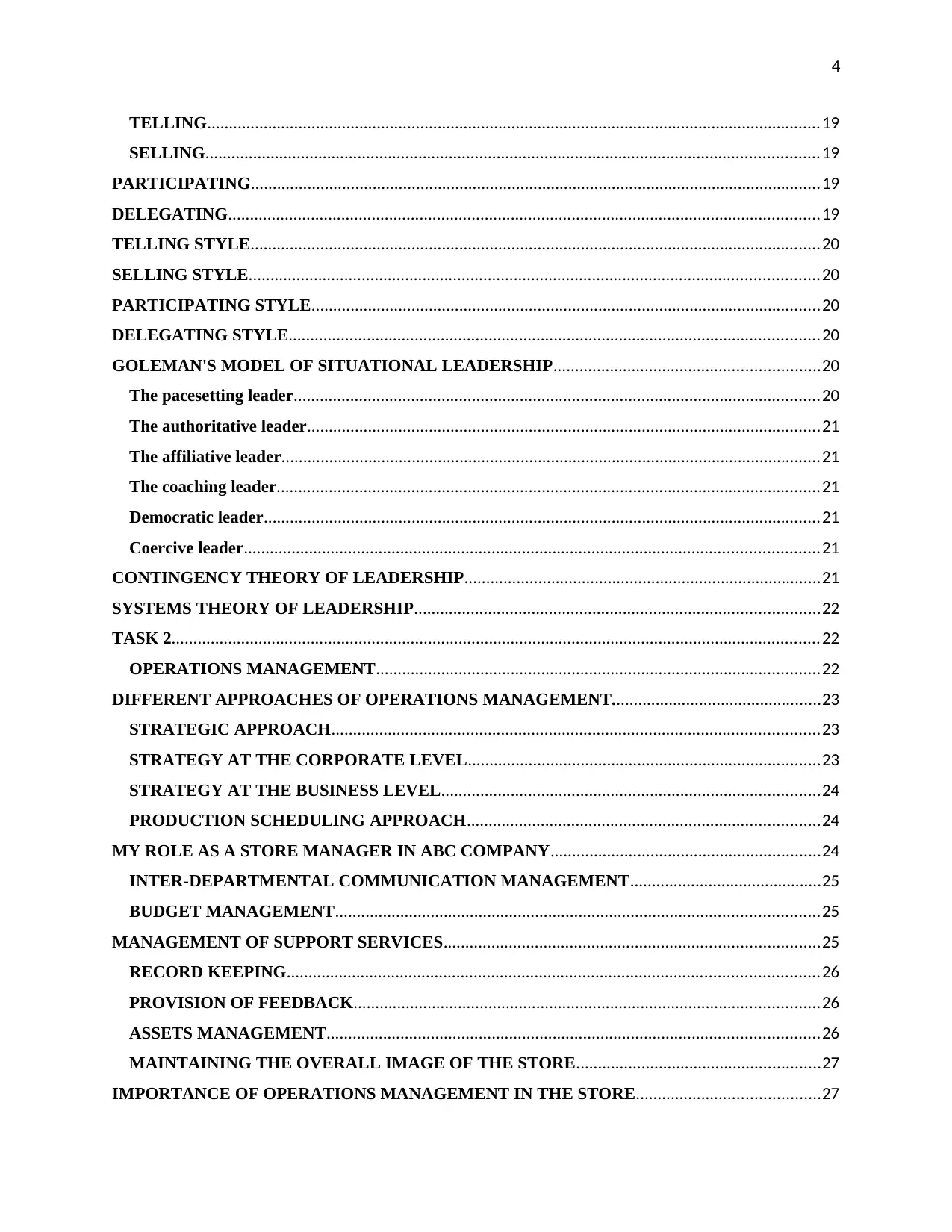
4
TELLING.............................................................................................................................................19
SELLING.............................................................................................................................................19
PARTICIPATING...................................................................................................................................19
DELEGATING........................................................................................................................................19
TELLING STYLE...................................................................................................................................20
SELLING STYLE...................................................................................................................................20
PARTICIPATING STYLE.....................................................................................................................20
DELEGATING STYLE..........................................................................................................................20
GOLEMAN'S MODEL OF SITUATIONAL LEADERSHIP.............................................................20
The pacesetting leader.........................................................................................................................20
The authoritative leader......................................................................................................................21
The affiliative leader............................................................................................................................21
The coaching leader.............................................................................................................................21
Democratic leader................................................................................................................................21
Coercive leader....................................................................................................................................21
CONTINGENCY THEORY OF LEADERSHIP..................................................................................21
SYSTEMS THEORY OF LEADERSHIP.............................................................................................22
TASK 2.....................................................................................................................................................22
OPERATIONS MANAGEMENT......................................................................................................22
DIFFERENT APPROACHES OF OPERATIONS MANAGEMENT................................................23
STRATEGIC APPROACH................................................................................................................23
STRATEGY AT THE CORPORATE LEVEL.................................................................................23
STRATEGY AT THE BUSINESS LEVEL.......................................................................................24
PRODUCTION SCHEDULING APPROACH.................................................................................24
MY ROLE AS A STORE MANAGER IN ABC COMPANY..............................................................24
INTER-DEPARTMENTAL COMMUNICATION MANAGEMENT............................................25
BUDGET MANAGEMENT...............................................................................................................25
MANAGEMENT OF SUPPORT SERVICES......................................................................................25
RECORD KEEPING..........................................................................................................................26
PROVISION OF FEEDBACK...........................................................................................................26
ASSETS MANAGEMENT.................................................................................................................26
MAINTAINING THE OVERALL IMAGE OF THE STORE........................................................27
IMPORTANCE OF OPERATIONS MANAGEMENT IN THE STORE..........................................27
TELLING.............................................................................................................................................19
SELLING.............................................................................................................................................19
PARTICIPATING...................................................................................................................................19
DELEGATING........................................................................................................................................19
TELLING STYLE...................................................................................................................................20
SELLING STYLE...................................................................................................................................20
PARTICIPATING STYLE.....................................................................................................................20
DELEGATING STYLE..........................................................................................................................20
GOLEMAN'S MODEL OF SITUATIONAL LEADERSHIP.............................................................20
The pacesetting leader.........................................................................................................................20
The authoritative leader......................................................................................................................21
The affiliative leader............................................................................................................................21
The coaching leader.............................................................................................................................21
Democratic leader................................................................................................................................21
Coercive leader....................................................................................................................................21
CONTINGENCY THEORY OF LEADERSHIP..................................................................................21
SYSTEMS THEORY OF LEADERSHIP.............................................................................................22
TASK 2.....................................................................................................................................................22
OPERATIONS MANAGEMENT......................................................................................................22
DIFFERENT APPROACHES OF OPERATIONS MANAGEMENT................................................23
STRATEGIC APPROACH................................................................................................................23
STRATEGY AT THE CORPORATE LEVEL.................................................................................23
STRATEGY AT THE BUSINESS LEVEL.......................................................................................24
PRODUCTION SCHEDULING APPROACH.................................................................................24
MY ROLE AS A STORE MANAGER IN ABC COMPANY..............................................................24
INTER-DEPARTMENTAL COMMUNICATION MANAGEMENT............................................25
BUDGET MANAGEMENT...............................................................................................................25
MANAGEMENT OF SUPPORT SERVICES......................................................................................25
RECORD KEEPING..........................................................................................................................26
PROVISION OF FEEDBACK...........................................................................................................26
ASSETS MANAGEMENT.................................................................................................................26
MAINTAINING THE OVERALL IMAGE OF THE STORE........................................................27
IMPORTANCE OF OPERATIONS MANAGEMENT IN THE STORE..........................................27
Secure Best Marks with AI Grader
Need help grading? Try our AI Grader for instant feedback on your assignments.
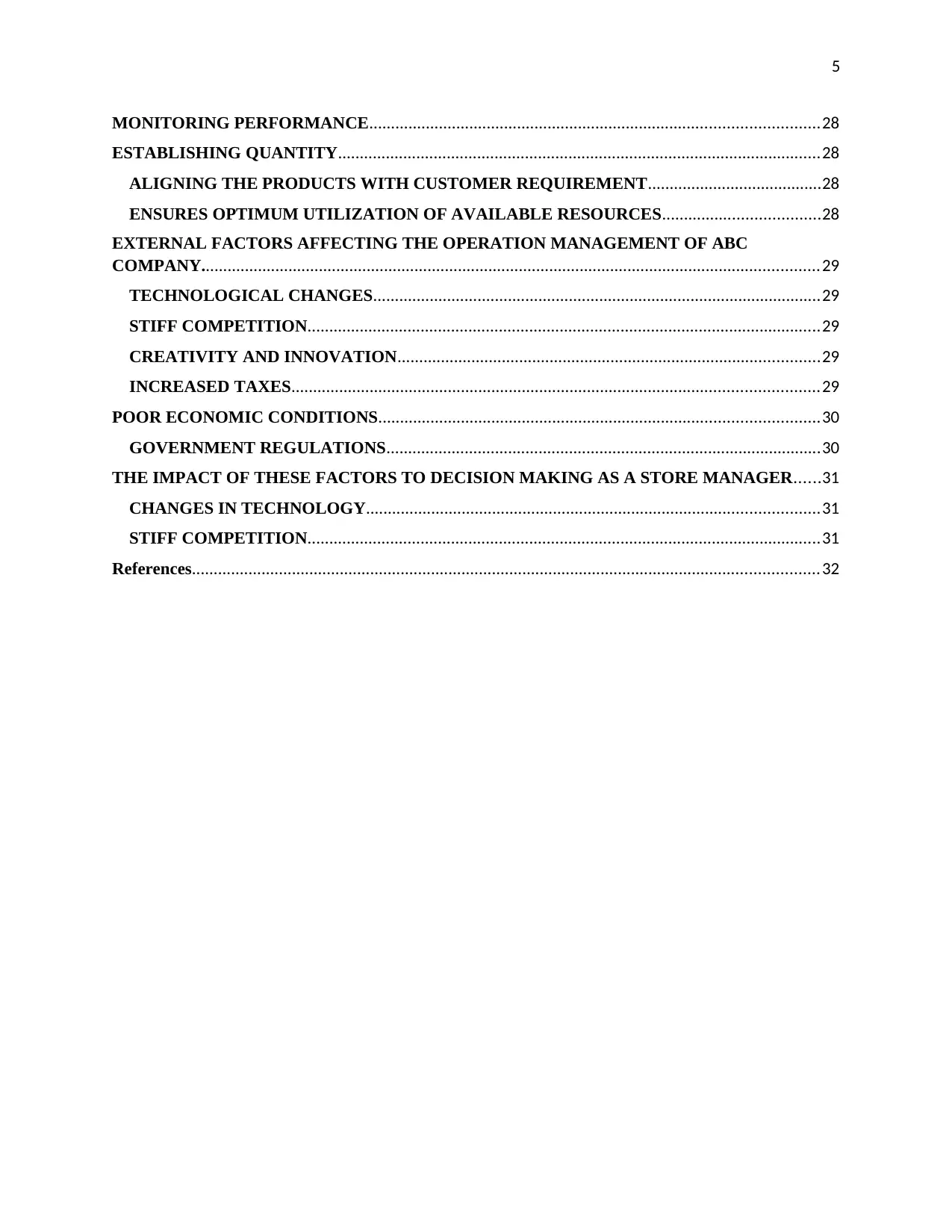
5
MONITORING PERFORMANCE.......................................................................................................28
ESTABLISHING QUANTITY...............................................................................................................28
ALIGNING THE PRODUCTS WITH CUSTOMER REQUIREMENT........................................28
ENSURES OPTIMUM UTILIZATION OF AVAILABLE RESOURCES....................................28
EXTERNAL FACTORS AFFECTING THE OPERATION MANAGEMENT OF ABC
COMPANY..............................................................................................................................................29
TECHNOLOGICAL CHANGES.......................................................................................................29
STIFF COMPETITION......................................................................................................................29
CREATIVITY AND INNOVATION.................................................................................................29
INCREASED TAXES.........................................................................................................................29
POOR ECONOMIC CONDITIONS.....................................................................................................30
GOVERNMENT REGULATIONS....................................................................................................30
THE IMPACT OF THESE FACTORS TO DECISION MAKING AS A STORE MANAGER......31
CHANGES IN TECHNOLOGY........................................................................................................31
STIFF COMPETITION......................................................................................................................31
References................................................................................................................................................32
MONITORING PERFORMANCE.......................................................................................................28
ESTABLISHING QUANTITY...............................................................................................................28
ALIGNING THE PRODUCTS WITH CUSTOMER REQUIREMENT........................................28
ENSURES OPTIMUM UTILIZATION OF AVAILABLE RESOURCES....................................28
EXTERNAL FACTORS AFFECTING THE OPERATION MANAGEMENT OF ABC
COMPANY..............................................................................................................................................29
TECHNOLOGICAL CHANGES.......................................................................................................29
STIFF COMPETITION......................................................................................................................29
CREATIVITY AND INNOVATION.................................................................................................29
INCREASED TAXES.........................................................................................................................29
POOR ECONOMIC CONDITIONS.....................................................................................................30
GOVERNMENT REGULATIONS....................................................................................................30
THE IMPACT OF THESE FACTORS TO DECISION MAKING AS A STORE MANAGER......31
CHANGES IN TECHNOLOGY........................................................................................................31
STIFF COMPETITION......................................................................................................................31
References................................................................................................................................................32
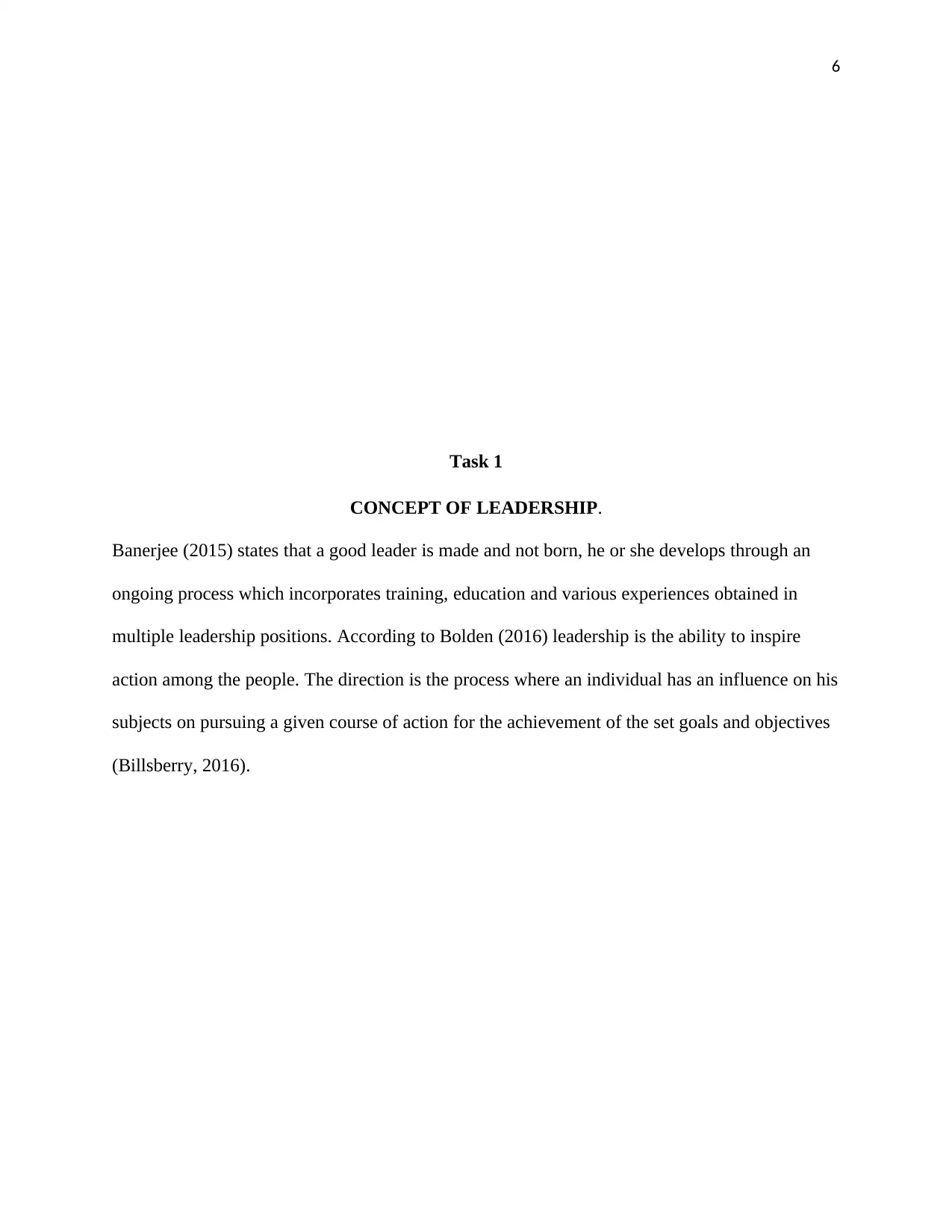
6
Task 1
CONCEPT OF LEADERSHIP.
Banerjee (2015) states that a good leader is made and not born, he or she develops through an
ongoing process which incorporates training, education and various experiences obtained in
multiple leadership positions. According to Bolden (2016) leadership is the ability to inspire
action among the people. The direction is the process where an individual has an influence on his
subjects on pursuing a given course of action for the achievement of the set goals and objectives
(Billsberry, 2016).
Task 1
CONCEPT OF LEADERSHIP.
Banerjee (2015) states that a good leader is made and not born, he or she develops through an
ongoing process which incorporates training, education and various experiences obtained in
multiple leadership positions. According to Bolden (2016) leadership is the ability to inspire
action among the people. The direction is the process where an individual has an influence on his
subjects on pursuing a given course of action for the achievement of the set goals and objectives
(Billsberry, 2016).
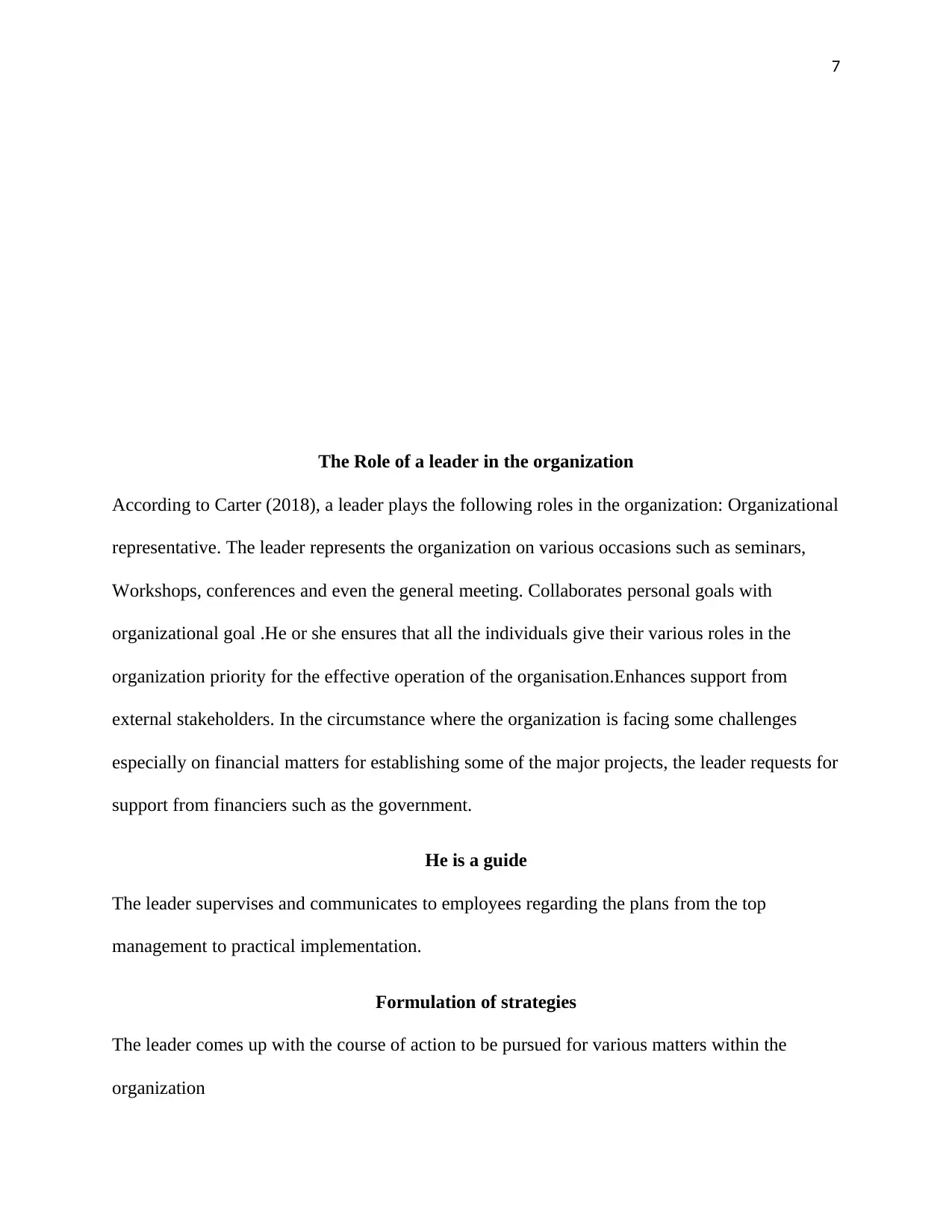
7
The Role of a leader in the organization
According to Carter (2018), a leader plays the following roles in the organization: Organizational
representative. The leader represents the organization on various occasions such as seminars,
Workshops, conferences and even the general meeting. Collaborates personal goals with
organizational goal .He or she ensures that all the individuals give their various roles in the
organization priority for the effective operation of the organisation.Enhances support from
external stakeholders. In the circumstance where the organization is facing some challenges
especially on financial matters for establishing some of the major projects, the leader requests for
support from financiers such as the government.
He is a guide
The leader supervises and communicates to employees regarding the plans from the top
management to practical implementation.
Formulation of strategies
The leader comes up with the course of action to be pursued for various matters within the
organization
The Role of a leader in the organization
According to Carter (2018), a leader plays the following roles in the organization: Organizational
representative. The leader represents the organization on various occasions such as seminars,
Workshops, conferences and even the general meeting. Collaborates personal goals with
organizational goal .He or she ensures that all the individuals give their various roles in the
organization priority for the effective operation of the organisation.Enhances support from
external stakeholders. In the circumstance where the organization is facing some challenges
especially on financial matters for establishing some of the major projects, the leader requests for
support from financiers such as the government.
He is a guide
The leader supervises and communicates to employees regarding the plans from the top
management to practical implementation.
Formulation of strategies
The leader comes up with the course of action to be pursued for various matters within the
organization
Paraphrase This Document
Need a fresh take? Get an instant paraphrase of this document with our AI Paraphraser

8
Evaluates performance
The leader measures the performance of the organization against the set objectives over a given
period
He is a philosopher
This is because he utilizes his intelligence and experience gathered from various aspects of
authority to facilitate action among the employees hence the achievement of the organizational
goals and objectives.
LEADERSHIP CHALLENGES
There various challenges associated with leadership hence a good leader should know how to
endure these challenges (DE Matthews, 2016). They are as discussed below:
A leader must maintain a sense of personal balance where has to ensure that he balances between
the duties bestowed upon him by the organization and his family life.
A leader cannot fight back those who mock him since he should maintain a high sense of
humility always.
People shall always have to talk negatively about a leader because he cannot impress everybody.
Effective leadership requires continuous learning and development which might be a problem
due to a lot of commitments by a leader.
Evaluates performance
The leader measures the performance of the organization against the set objectives over a given
period
He is a philosopher
This is because he utilizes his intelligence and experience gathered from various aspects of
authority to facilitate action among the employees hence the achievement of the organizational
goals and objectives.
LEADERSHIP CHALLENGES
There various challenges associated with leadership hence a good leader should know how to
endure these challenges (DE Matthews, 2016). They are as discussed below:
A leader must maintain a sense of personal balance where has to ensure that he balances between
the duties bestowed upon him by the organization and his family life.
A leader cannot fight back those who mock him since he should maintain a high sense of
humility always.
People shall always have to talk negatively about a leader because he cannot impress everybody.
Effective leadership requires continuous learning and development which might be a problem
due to a lot of commitments by a leader.
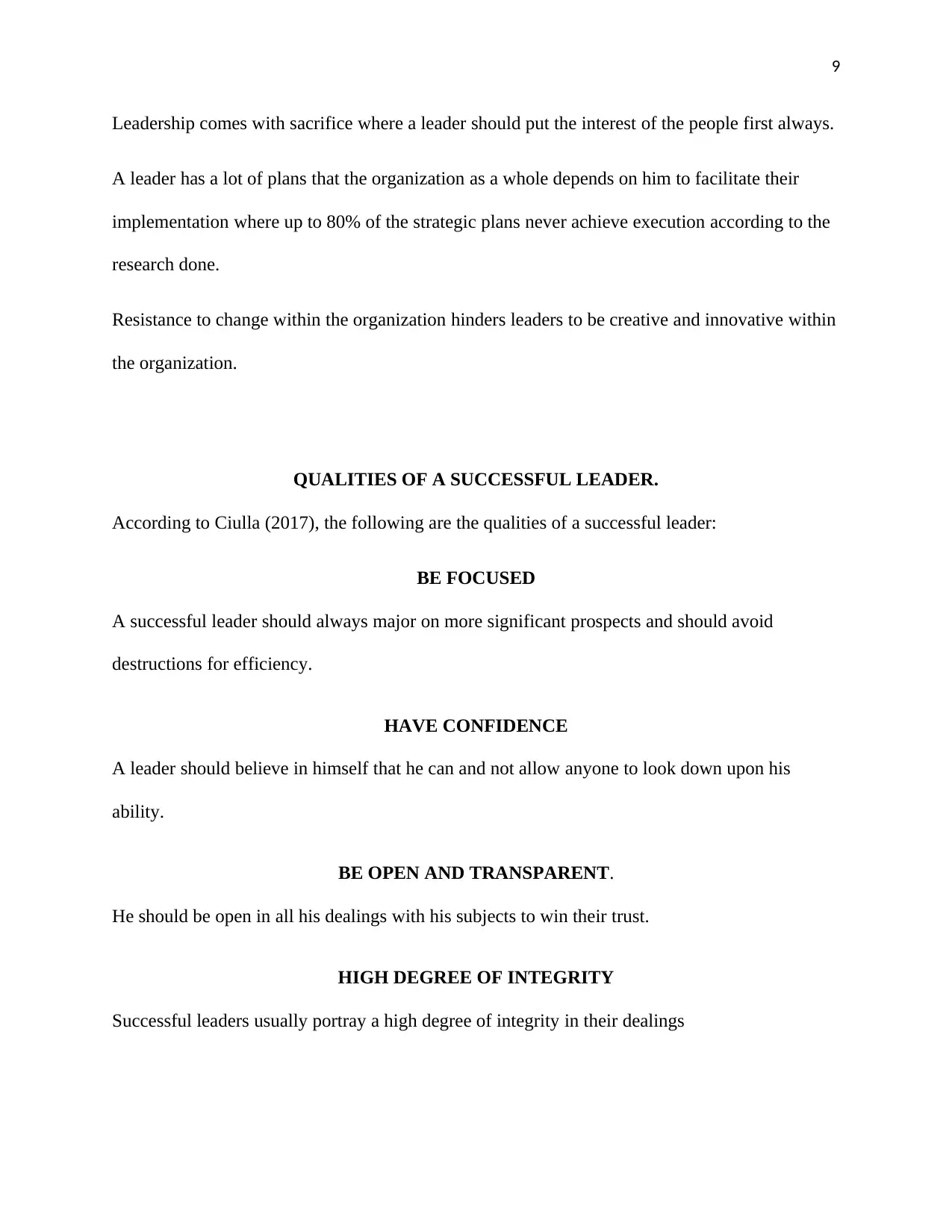
9
Leadership comes with sacrifice where a leader should put the interest of the people first always.
A leader has a lot of plans that the organization as a whole depends on him to facilitate their
implementation where up to 80% of the strategic plans never achieve execution according to the
research done.
Resistance to change within the organization hinders leaders to be creative and innovative within
the organization.
QUALITIES OF A SUCCESSFUL LEADER.
According to Ciulla (2017), the following are the qualities of a successful leader:
BE FOCUSED
A successful leader should always major on more significant prospects and should avoid
destructions for efficiency.
HAVE CONFIDENCE
A leader should believe in himself that he can and not allow anyone to look down upon his
ability.
BE OPEN AND TRANSPARENT.
He should be open in all his dealings with his subjects to win their trust.
HIGH DEGREE OF INTEGRITY
Successful leaders usually portray a high degree of integrity in their dealings
Leadership comes with sacrifice where a leader should put the interest of the people first always.
A leader has a lot of plans that the organization as a whole depends on him to facilitate their
implementation where up to 80% of the strategic plans never achieve execution according to the
research done.
Resistance to change within the organization hinders leaders to be creative and innovative within
the organization.
QUALITIES OF A SUCCESSFUL LEADER.
According to Ciulla (2017), the following are the qualities of a successful leader:
BE FOCUSED
A successful leader should always major on more significant prospects and should avoid
destructions for efficiency.
HAVE CONFIDENCE
A leader should believe in himself that he can and not allow anyone to look down upon his
ability.
BE OPEN AND TRANSPARENT.
He should be open in all his dealings with his subjects to win their trust.
HIGH DEGREE OF INTEGRITY
Successful leaders usually portray a high degree of integrity in their dealings
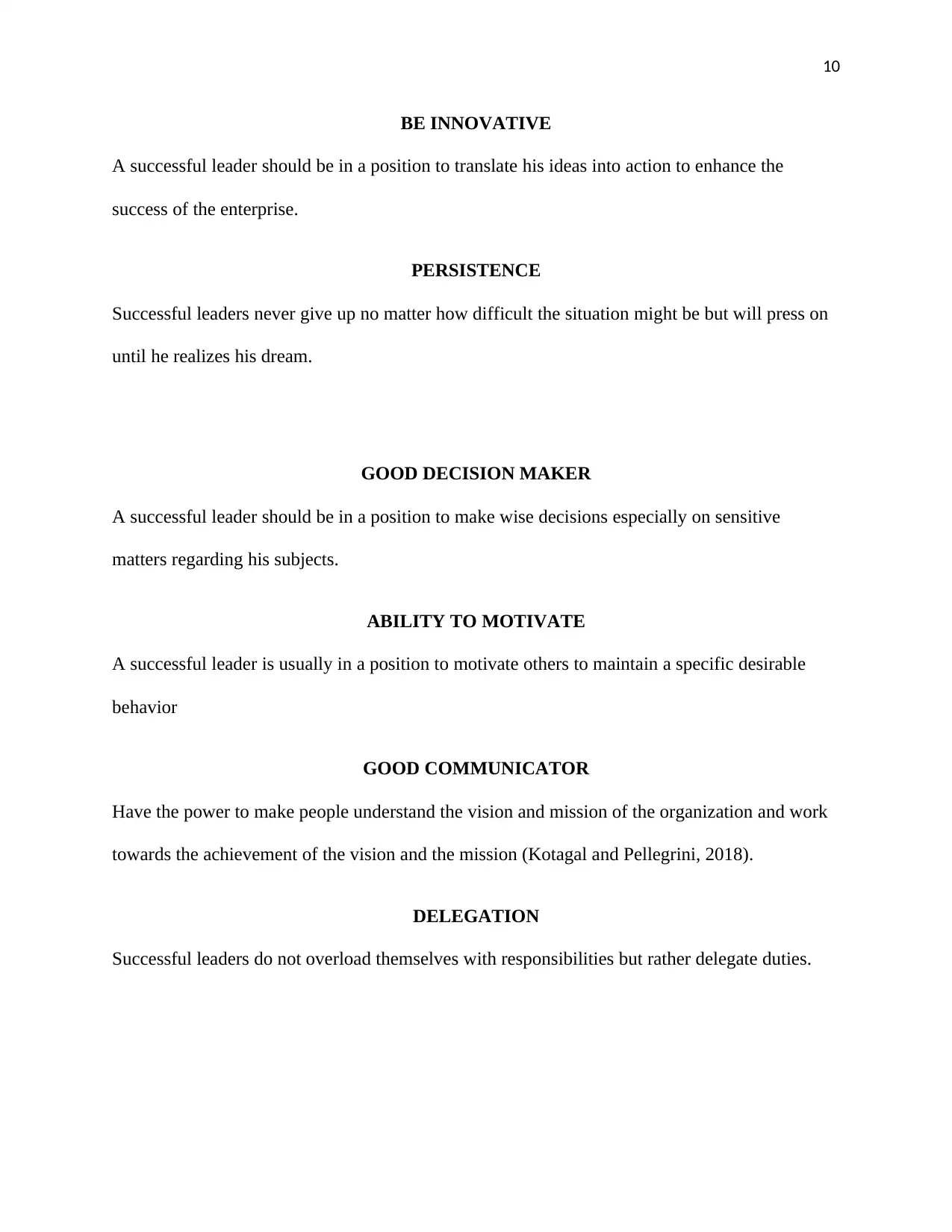
10
BE INNOVATIVE
A successful leader should be in a position to translate his ideas into action to enhance the
success of the enterprise.
PERSISTENCE
Successful leaders never give up no matter how difficult the situation might be but will press on
until he realizes his dream.
GOOD DECISION MAKER
A successful leader should be in a position to make wise decisions especially on sensitive
matters regarding his subjects.
ABILITY TO MOTIVATE
A successful leader is usually in a position to motivate others to maintain a specific desirable
behavior
GOOD COMMUNICATOR
Have the power to make people understand the vision and mission of the organization and work
towards the achievement of the vision and the mission (Kotagal and Pellegrini, 2018).
DELEGATION
Successful leaders do not overload themselves with responsibilities but rather delegate duties.
BE INNOVATIVE
A successful leader should be in a position to translate his ideas into action to enhance the
success of the enterprise.
PERSISTENCE
Successful leaders never give up no matter how difficult the situation might be but will press on
until he realizes his dream.
GOOD DECISION MAKER
A successful leader should be in a position to make wise decisions especially on sensitive
matters regarding his subjects.
ABILITY TO MOTIVATE
A successful leader is usually in a position to motivate others to maintain a specific desirable
behavior
GOOD COMMUNICATOR
Have the power to make people understand the vision and mission of the organization and work
towards the achievement of the vision and the mission (Kotagal and Pellegrini, 2018).
DELEGATION
Successful leaders do not overload themselves with responsibilities but rather delegate duties.
Secure Best Marks with AI Grader
Need help grading? Try our AI Grader for instant feedback on your assignments.
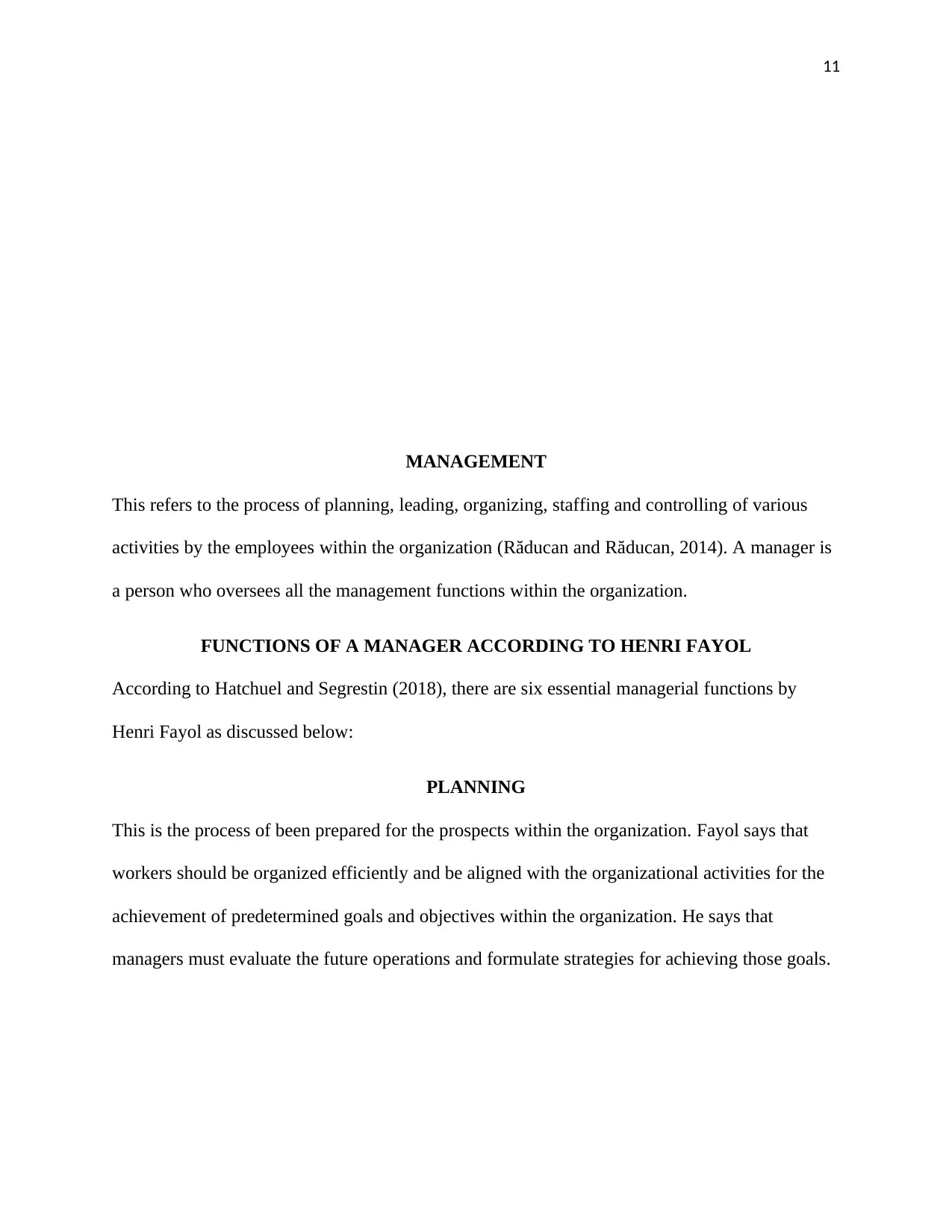
11
MANAGEMENT
This refers to the process of planning, leading, organizing, staffing and controlling of various
activities by the employees within the organization (Răducan and Răducan, 2014). A manager is
a person who oversees all the management functions within the organization.
FUNCTIONS OF A MANAGER ACCORDING TO HENRI FAYOL
According to Hatchuel and Segrestin (2018), there are six essential managerial functions by
Henri Fayol as discussed below:
PLANNING
This is the process of been prepared for the prospects within the organization. Fayol says that
workers should be organized efficiently and be aligned with the organizational activities for the
achievement of predetermined goals and objectives within the organization. He says that
managers must evaluate the future operations and formulate strategies for achieving those goals.
MANAGEMENT
This refers to the process of planning, leading, organizing, staffing and controlling of various
activities by the employees within the organization (Răducan and Răducan, 2014). A manager is
a person who oversees all the management functions within the organization.
FUNCTIONS OF A MANAGER ACCORDING TO HENRI FAYOL
According to Hatchuel and Segrestin (2018), there are six essential managerial functions by
Henri Fayol as discussed below:
PLANNING
This is the process of been prepared for the prospects within the organization. Fayol says that
workers should be organized efficiently and be aligned with the organizational activities for the
achievement of predetermined goals and objectives within the organization. He says that
managers must evaluate the future operations and formulate strategies for achieving those goals.
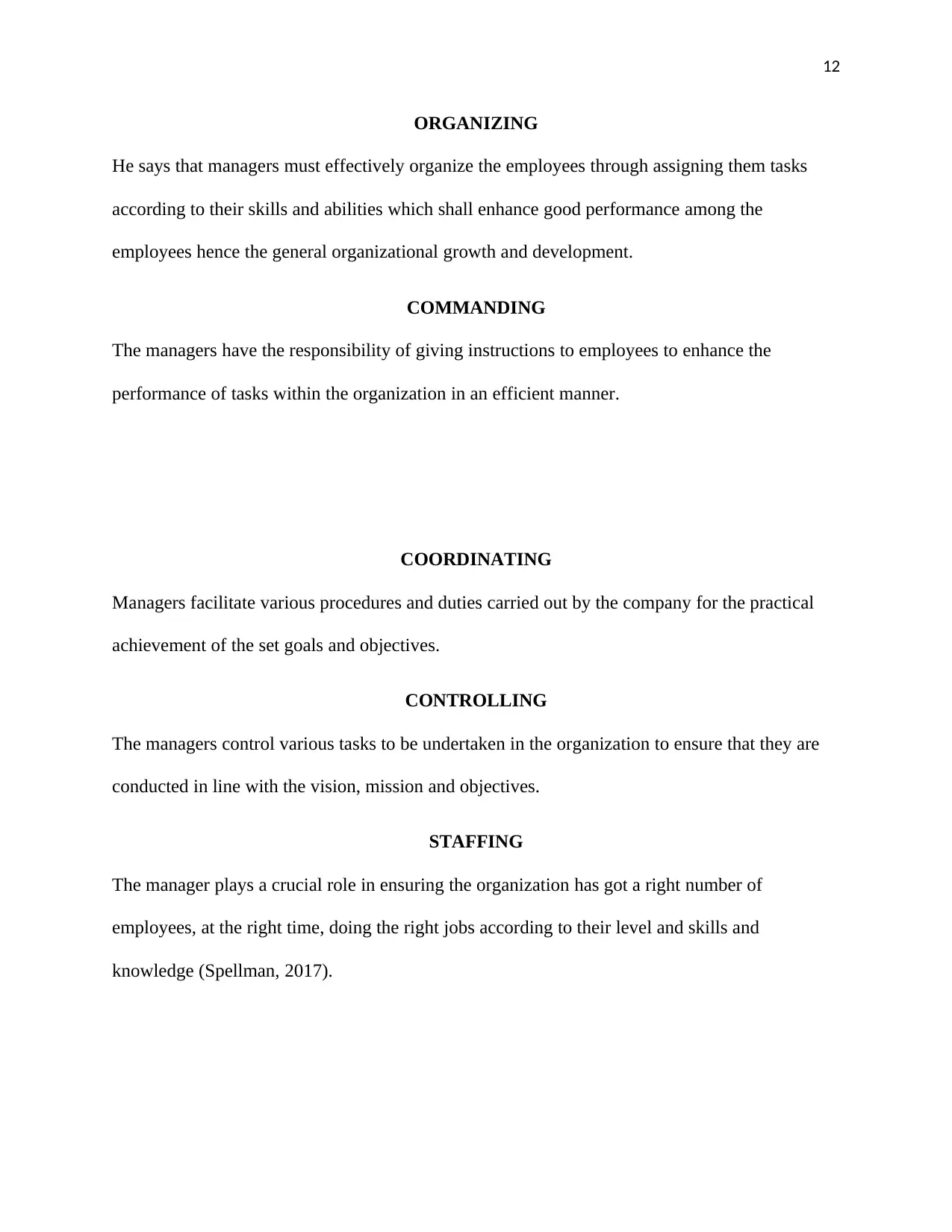
12
ORGANIZING
He says that managers must effectively organize the employees through assigning them tasks
according to their skills and abilities which shall enhance good performance among the
employees hence the general organizational growth and development.
COMMANDING
The managers have the responsibility of giving instructions to employees to enhance the
performance of tasks within the organization in an efficient manner.
COORDINATING
Managers facilitate various procedures and duties carried out by the company for the practical
achievement of the set goals and objectives.
CONTROLLING
The managers control various tasks to be undertaken in the organization to ensure that they are
conducted in line with the vision, mission and objectives.
STAFFING
The manager plays a crucial role in ensuring the organization has got a right number of
employees, at the right time, doing the right jobs according to their level and skills and
knowledge (Spellman, 2017).
ORGANIZING
He says that managers must effectively organize the employees through assigning them tasks
according to their skills and abilities which shall enhance good performance among the
employees hence the general organizational growth and development.
COMMANDING
The managers have the responsibility of giving instructions to employees to enhance the
performance of tasks within the organization in an efficient manner.
COORDINATING
Managers facilitate various procedures and duties carried out by the company for the practical
achievement of the set goals and objectives.
CONTROLLING
The managers control various tasks to be undertaken in the organization to ensure that they are
conducted in line with the vision, mission and objectives.
STAFFING
The manager plays a crucial role in ensuring the organization has got a right number of
employees, at the right time, doing the right jobs according to their level and skills and
knowledge (Spellman, 2017).
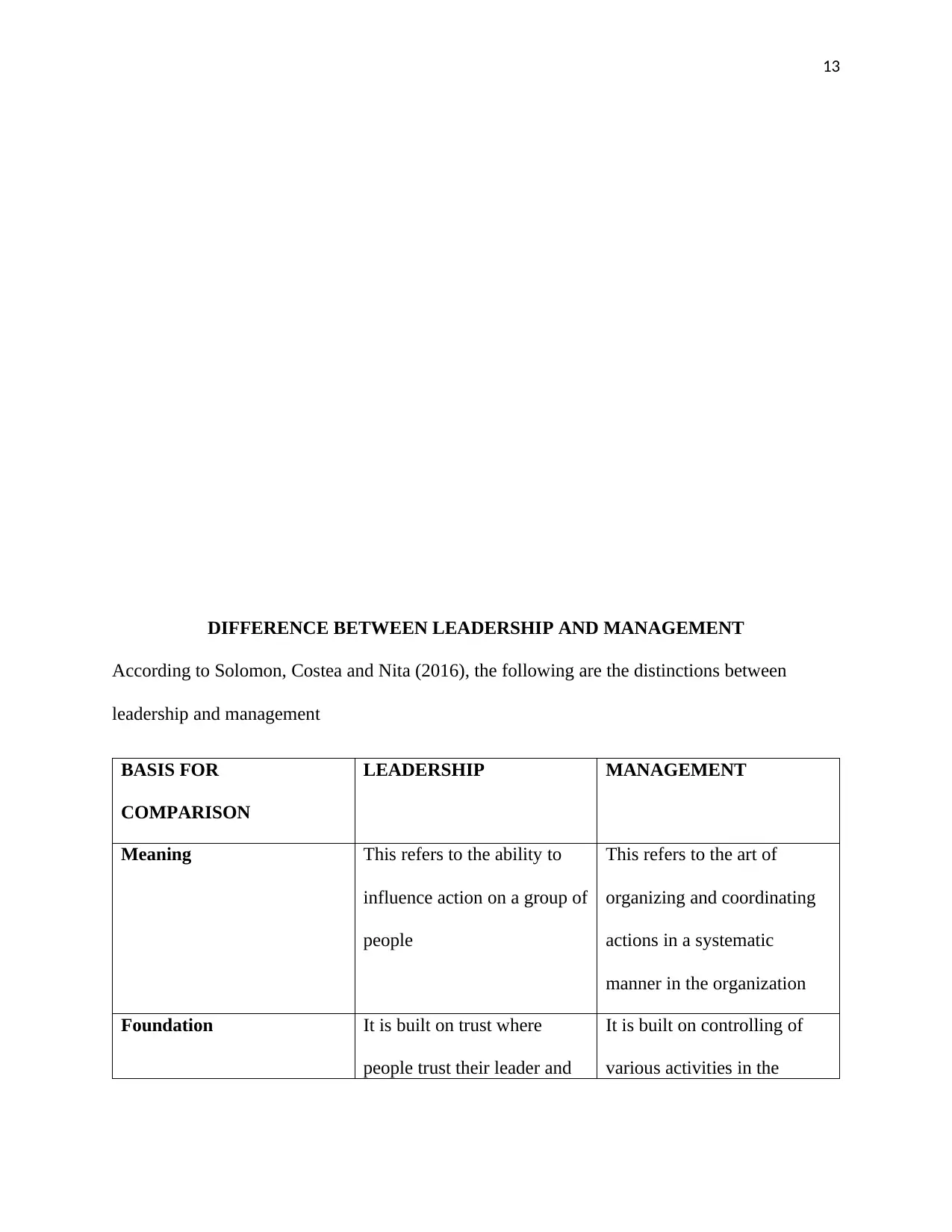
13
DIFFERENCE BETWEEN LEADERSHIP AND MANAGEMENT
According to Solomon, Costea and Nita (2016), the following are the distinctions between
leadership and management
BASIS FOR
COMPARISON
LEADERSHIP MANAGEMENT
Meaning This refers to the ability to
influence action on a group of
people
This refers to the art of
organizing and coordinating
actions in a systematic
manner in the organization
Foundation It is built on trust where
people trust their leader and
It is built on controlling of
various activities in the
DIFFERENCE BETWEEN LEADERSHIP AND MANAGEMENT
According to Solomon, Costea and Nita (2016), the following are the distinctions between
leadership and management
BASIS FOR
COMPARISON
LEADERSHIP MANAGEMENT
Meaning This refers to the ability to
influence action on a group of
people
This refers to the art of
organizing and coordinating
actions in a systematic
manner in the organization
Foundation It is built on trust where
people trust their leader and
It is built on controlling of
various activities in the
Paraphrase This Document
Need a fresh take? Get an instant paraphrase of this document with our AI Paraphraser
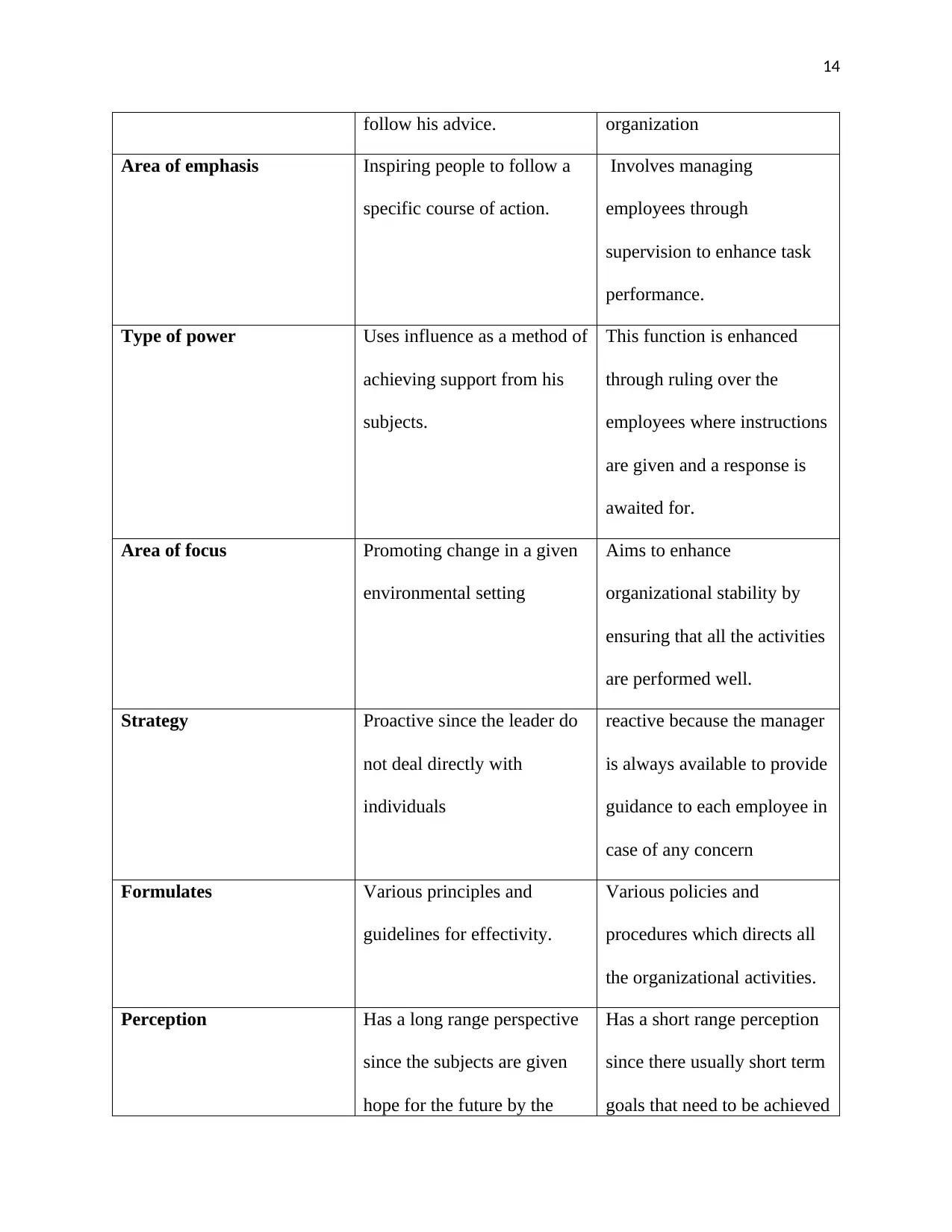
14
follow his advice. organization
Area of emphasis Inspiring people to follow a
specific course of action.
Involves managing
employees through
supervision to enhance task
performance.
Type of power Uses influence as a method of
achieving support from his
subjects.
This function is enhanced
through ruling over the
employees where instructions
are given and a response is
awaited for.
Area of focus Promoting change in a given
environmental setting
Aims to enhance
organizational stability by
ensuring that all the activities
are performed well.
Strategy Proactive since the leader do
not deal directly with
individuals
reactive because the manager
is always available to provide
guidance to each employee in
case of any concern
Formulates Various principles and
guidelines for effectivity.
Various policies and
procedures which directs all
the organizational activities.
Perception Has a long range perspective
since the subjects are given
hope for the future by the
Has a short range perception
since there usually short term
goals that need to be achieved
follow his advice. organization
Area of emphasis Inspiring people to follow a
specific course of action.
Involves managing
employees through
supervision to enhance task
performance.
Type of power Uses influence as a method of
achieving support from his
subjects.
This function is enhanced
through ruling over the
employees where instructions
are given and a response is
awaited for.
Area of focus Promoting change in a given
environmental setting
Aims to enhance
organizational stability by
ensuring that all the activities
are performed well.
Strategy Proactive since the leader do
not deal directly with
individuals
reactive because the manager
is always available to provide
guidance to each employee in
case of any concern
Formulates Various principles and
guidelines for effectivity.
Various policies and
procedures which directs all
the organizational activities.
Perception Has a long range perspective
since the subjects are given
hope for the future by the
Has a short range perception
since there usually short term
goals that need to be achieved
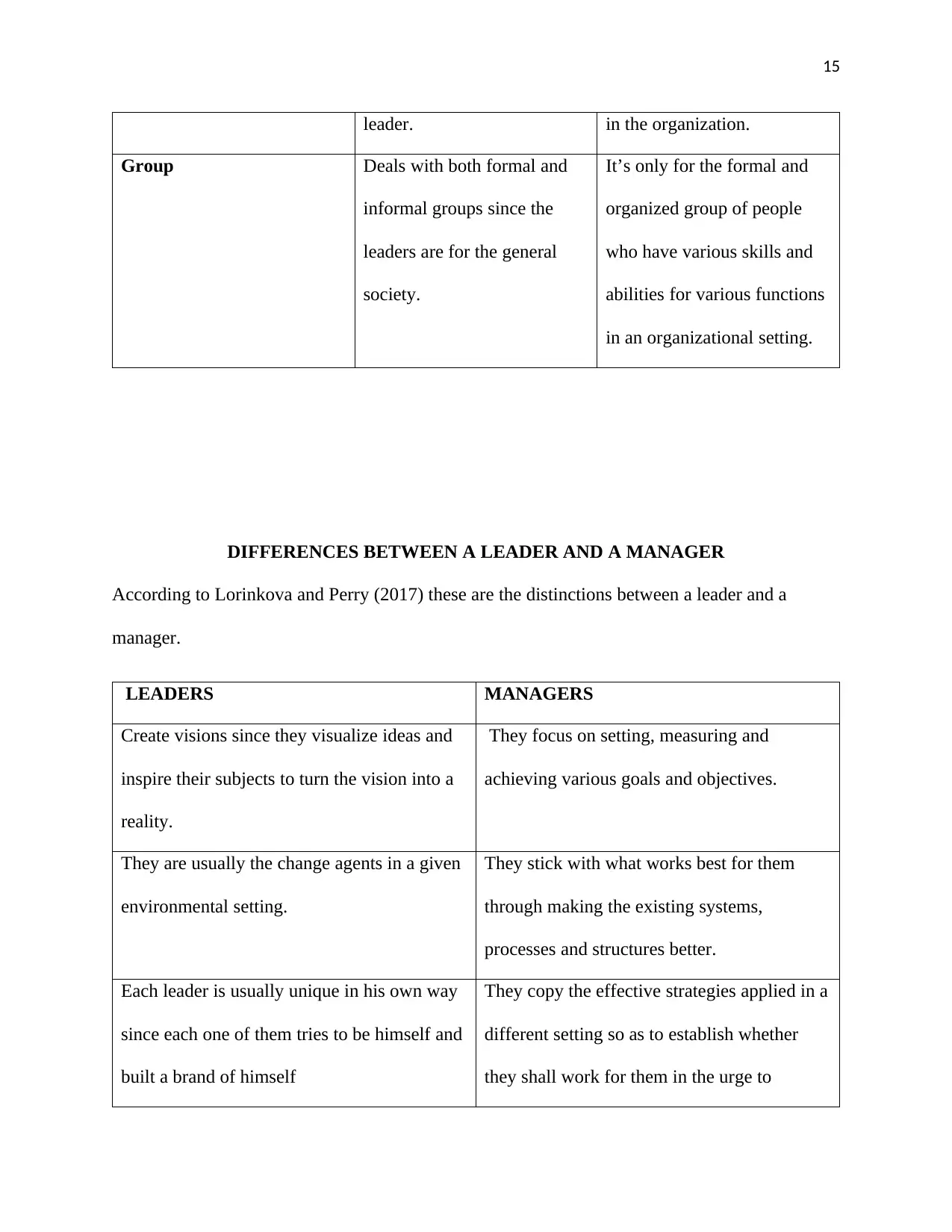
15
leader. in the organization.
Group Deals with both formal and
informal groups since the
leaders are for the general
society.
It’s only for the formal and
organized group of people
who have various skills and
abilities for various functions
in an organizational setting.
DIFFERENCES BETWEEN A LEADER AND A MANAGER
According to Lorinkova and Perry (2017) these are the distinctions between a leader and a
manager.
LEADERS MANAGERS
Create visions since they visualize ideas and
inspire their subjects to turn the vision into a
reality.
They focus on setting, measuring and
achieving various goals and objectives.
They are usually the change agents in a given
environmental setting.
They stick with what works best for them
through making the existing systems,
processes and structures better.
Each leader is usually unique in his own way
since each one of them tries to be himself and
built a brand of himself
They copy the effective strategies applied in a
different setting so as to establish whether
they shall work for them in the urge to
leader. in the organization.
Group Deals with both formal and
informal groups since the
leaders are for the general
society.
It’s only for the formal and
organized group of people
who have various skills and
abilities for various functions
in an organizational setting.
DIFFERENCES BETWEEN A LEADER AND A MANAGER
According to Lorinkova and Perry (2017) these are the distinctions between a leader and a
manager.
LEADERS MANAGERS
Create visions since they visualize ideas and
inspire their subjects to turn the vision into a
reality.
They focus on setting, measuring and
achieving various goals and objectives.
They are usually the change agents in a given
environmental setting.
They stick with what works best for them
through making the existing systems,
processes and structures better.
Each leader is usually unique in his own way
since each one of them tries to be himself and
built a brand of himself
They copy the effective strategies applied in a
different setting so as to establish whether
they shall work for them in the urge to
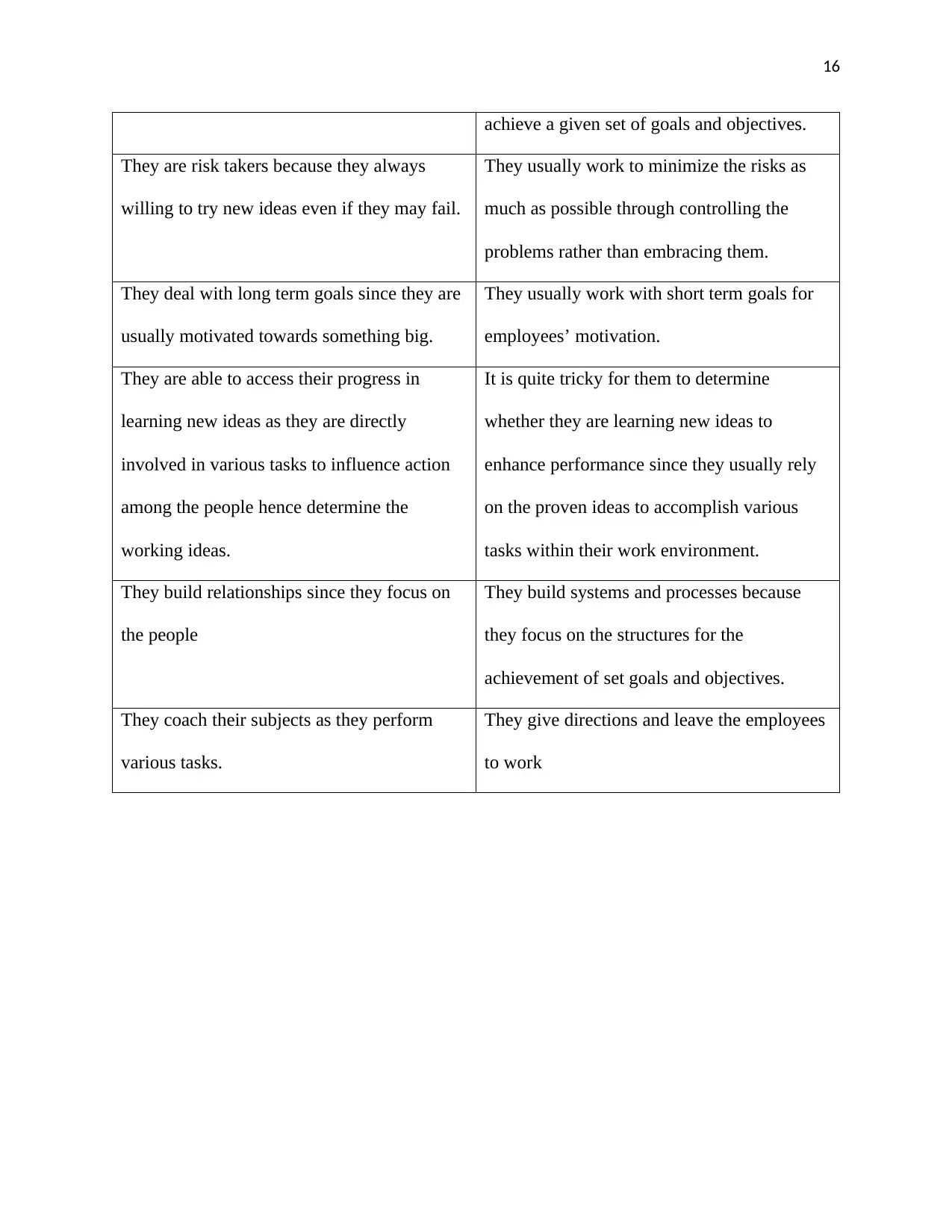
16
achieve a given set of goals and objectives.
They are risk takers because they always
willing to try new ideas even if they may fail.
They usually work to minimize the risks as
much as possible through controlling the
problems rather than embracing them.
They deal with long term goals since they are
usually motivated towards something big.
They usually work with short term goals for
employees’ motivation.
They are able to access their progress in
learning new ideas as they are directly
involved in various tasks to influence action
among the people hence determine the
working ideas.
It is quite tricky for them to determine
whether they are learning new ideas to
enhance performance since they usually rely
on the proven ideas to accomplish various
tasks within their work environment.
They build relationships since they focus on
the people
They build systems and processes because
they focus on the structures for the
achievement of set goals and objectives.
They coach their subjects as they perform
various tasks.
They give directions and leave the employees
to work
achieve a given set of goals and objectives.
They are risk takers because they always
willing to try new ideas even if they may fail.
They usually work to minimize the risks as
much as possible through controlling the
problems rather than embracing them.
They deal with long term goals since they are
usually motivated towards something big.
They usually work with short term goals for
employees’ motivation.
They are able to access their progress in
learning new ideas as they are directly
involved in various tasks to influence action
among the people hence determine the
working ideas.
It is quite tricky for them to determine
whether they are learning new ideas to
enhance performance since they usually rely
on the proven ideas to accomplish various
tasks within their work environment.
They build relationships since they focus on
the people
They build systems and processes because
they focus on the structures for the
achievement of set goals and objectives.
They coach their subjects as they perform
various tasks.
They give directions and leave the employees
to work
Secure Best Marks with AI Grader
Need help grading? Try our AI Grader for instant feedback on your assignments.
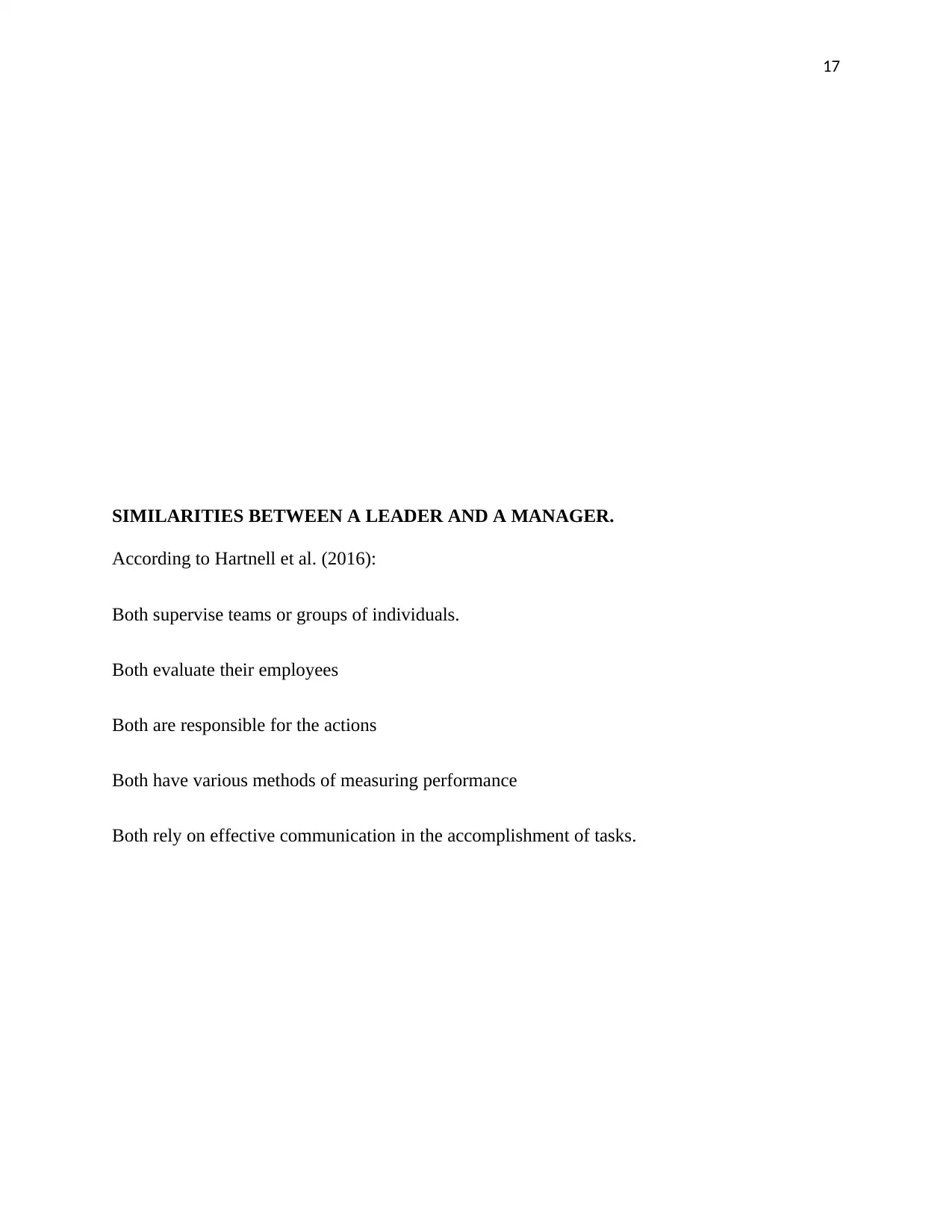
17
SIMILARITIES BETWEEN A LEADER AND A MANAGER.
According to Hartnell et al. (2016):
Both supervise teams or groups of individuals.
Both evaluate their employees
Both are responsible for the actions
Both have various methods of measuring performance
Both rely on effective communication in the accomplishment of tasks.
SIMILARITIES BETWEEN A LEADER AND A MANAGER.
According to Hartnell et al. (2016):
Both supervise teams or groups of individuals.
Both evaluate their employees
Both are responsible for the actions
Both have various methods of measuring performance
Both rely on effective communication in the accomplishment of tasks.

18
SITUATIONAL THEORY OF LEADERSHIP
Various theories have been developed to discuss the situational aspects of leadership. Each
method tries to bring out its idea on how leadership can be very successful in different situations.
Some few critical situational ways of administration are as discussed below.
HERSEY AND BLANCHARD'S SITUATIONAL THEORY OF LEADERSHIP.
According to McCleskey (2014), this leadership approach suggests that there is a need to align
the leadership style of a leader and the level of preparedness of the followers (followers'
maturity). From this theory there are four main approaches to leadership which are:
TELLING
It is an authoritative and directive approach where the leader is the key decision maker and
instructs the employees the course of action to be pursued in various circumstances
SITUATIONAL THEORY OF LEADERSHIP
Various theories have been developed to discuss the situational aspects of leadership. Each
method tries to bring out its idea on how leadership can be very successful in different situations.
Some few critical situational ways of administration are as discussed below.
HERSEY AND BLANCHARD'S SITUATIONAL THEORY OF LEADERSHIP.
According to McCleskey (2014), this leadership approach suggests that there is a need to align
the leadership style of a leader and the level of preparedness of the followers (followers'
maturity). From this theory there are four main approaches to leadership which are:
TELLING
It is an authoritative and directive approach where the leader is the key decision maker and
instructs the employees the course of action to be pursued in various circumstances
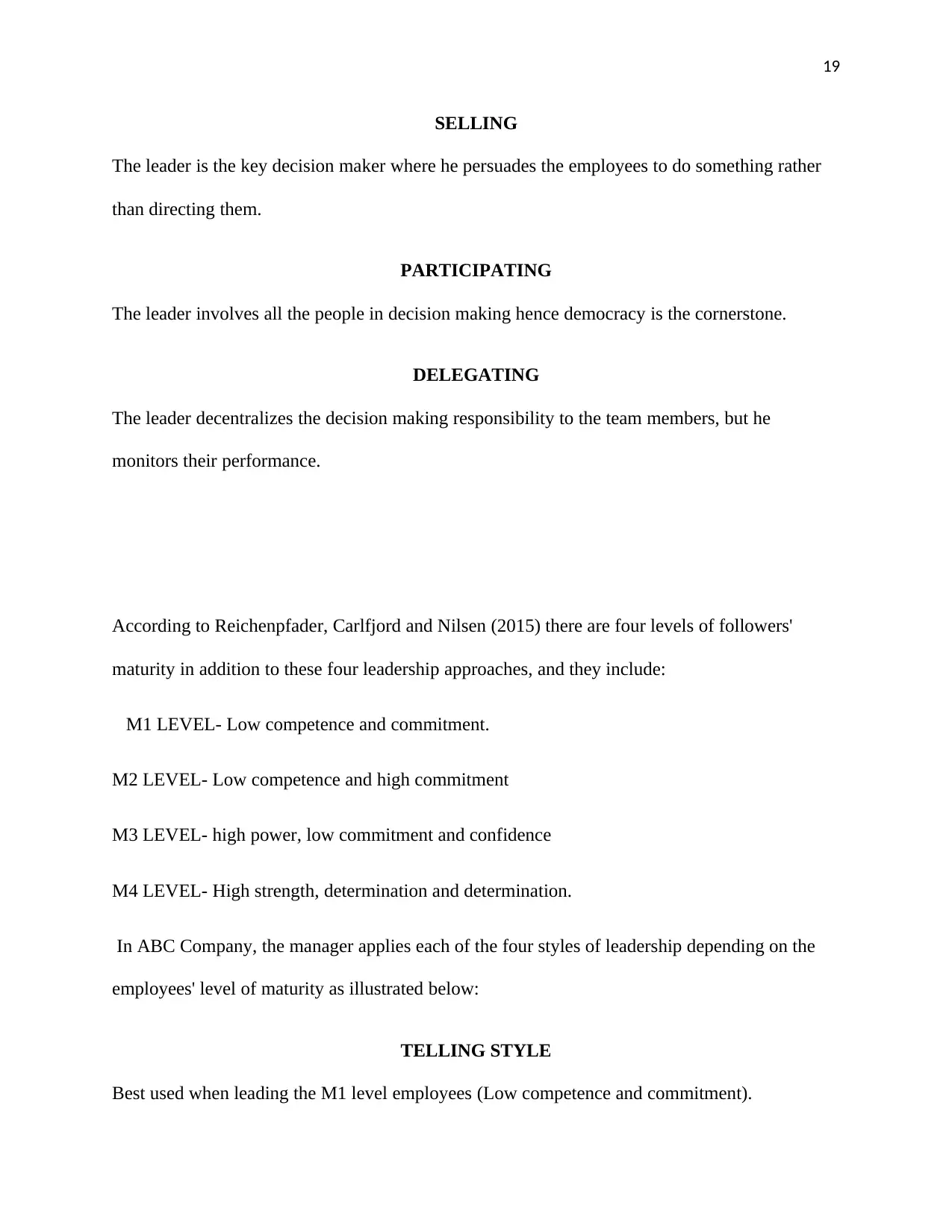
19
SELLING
The leader is the key decision maker where he persuades the employees to do something rather
than directing them.
PARTICIPATING
The leader involves all the people in decision making hence democracy is the cornerstone.
DELEGATING
The leader decentralizes the decision making responsibility to the team members, but he
monitors their performance.
According to Reichenpfader, Carlfjord and Nilsen (2015) there are four levels of followers'
maturity in addition to these four leadership approaches, and they include:
M1 LEVEL- Low competence and commitment.
M2 LEVEL- Low competence and high commitment
M3 LEVEL- high power, low commitment and confidence
M4 LEVEL- High strength, determination and determination.
In ABC Company, the manager applies each of the four styles of leadership depending on the
employees' level of maturity as illustrated below:
TELLING STYLE
Best used when leading the M1 level employees (Low competence and commitment).
SELLING
The leader is the key decision maker where he persuades the employees to do something rather
than directing them.
PARTICIPATING
The leader involves all the people in decision making hence democracy is the cornerstone.
DELEGATING
The leader decentralizes the decision making responsibility to the team members, but he
monitors their performance.
According to Reichenpfader, Carlfjord and Nilsen (2015) there are four levels of followers'
maturity in addition to these four leadership approaches, and they include:
M1 LEVEL- Low competence and commitment.
M2 LEVEL- Low competence and high commitment
M3 LEVEL- high power, low commitment and confidence
M4 LEVEL- High strength, determination and determination.
In ABC Company, the manager applies each of the four styles of leadership depending on the
employees' level of maturity as illustrated below:
TELLING STYLE
Best used when leading the M1 level employees (Low competence and commitment).
Paraphrase This Document
Need a fresh take? Get an instant paraphrase of this document with our AI Paraphraser
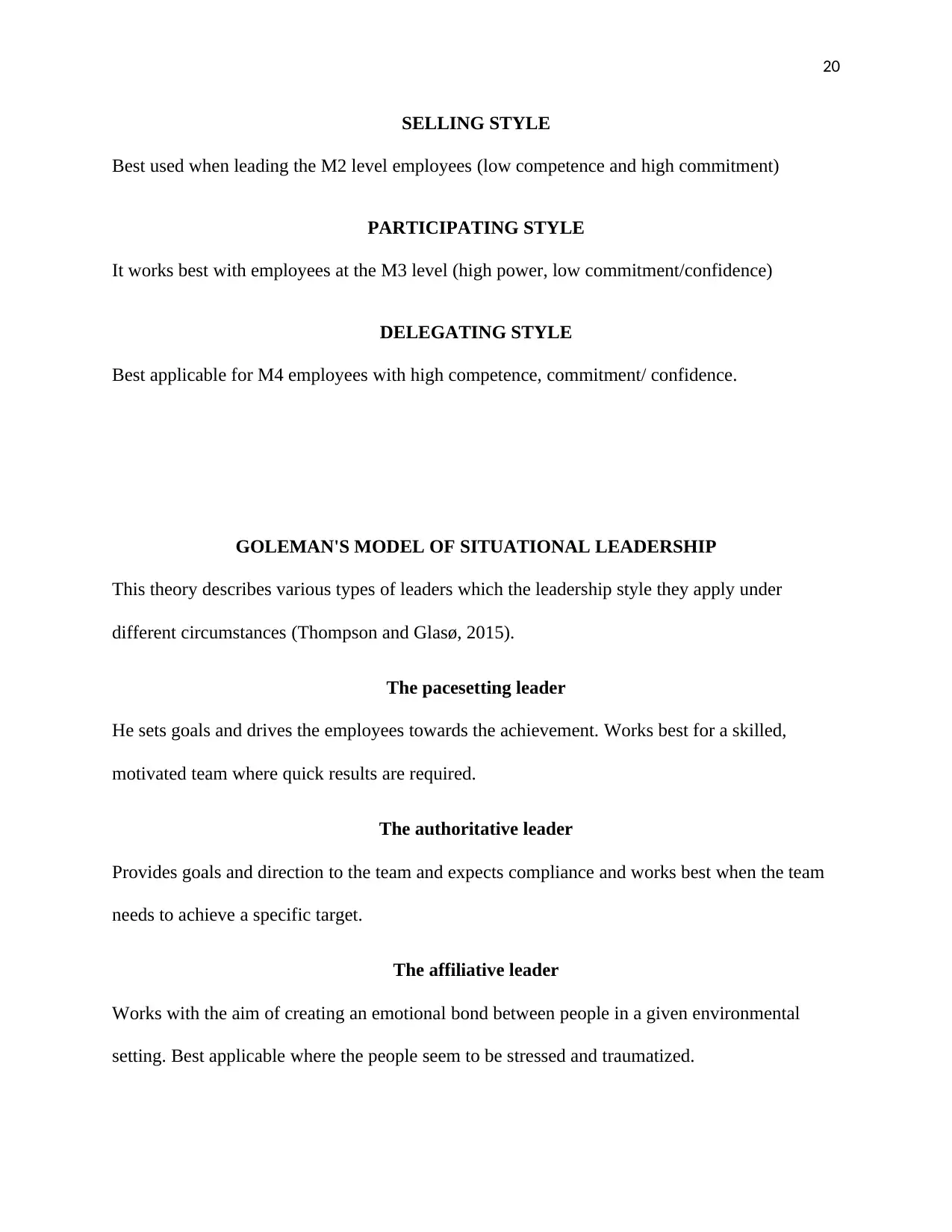
20
SELLING STYLE
Best used when leading the M2 level employees (low competence and high commitment)
PARTICIPATING STYLE
It works best with employees at the M3 level (high power, low commitment/confidence)
DELEGATING STYLE
Best applicable for M4 employees with high competence, commitment/ confidence.
GOLEMAN'S MODEL OF SITUATIONAL LEADERSHIP
This theory describes various types of leaders which the leadership style they apply under
different circumstances (Thompson and Glasø, 2015).
The pacesetting leader
He sets goals and drives the employees towards the achievement. Works best for a skilled,
motivated team where quick results are required.
The authoritative leader
Provides goals and direction to the team and expects compliance and works best when the team
needs to achieve a specific target.
The affiliative leader
Works with the aim of creating an emotional bond between people in a given environmental
setting. Best applicable where the people seem to be stressed and traumatized.
SELLING STYLE
Best used when leading the M2 level employees (low competence and high commitment)
PARTICIPATING STYLE
It works best with employees at the M3 level (high power, low commitment/confidence)
DELEGATING STYLE
Best applicable for M4 employees with high competence, commitment/ confidence.
GOLEMAN'S MODEL OF SITUATIONAL LEADERSHIP
This theory describes various types of leaders which the leadership style they apply under
different circumstances (Thompson and Glasø, 2015).
The pacesetting leader
He sets goals and drives the employees towards the achievement. Works best for a skilled,
motivated team where quick results are required.
The authoritative leader
Provides goals and direction to the team and expects compliance and works best when the team
needs to achieve a specific target.
The affiliative leader
Works with the aim of creating an emotional bond between people in a given environmental
setting. Best applicable where the people seem to be stressed and traumatized.
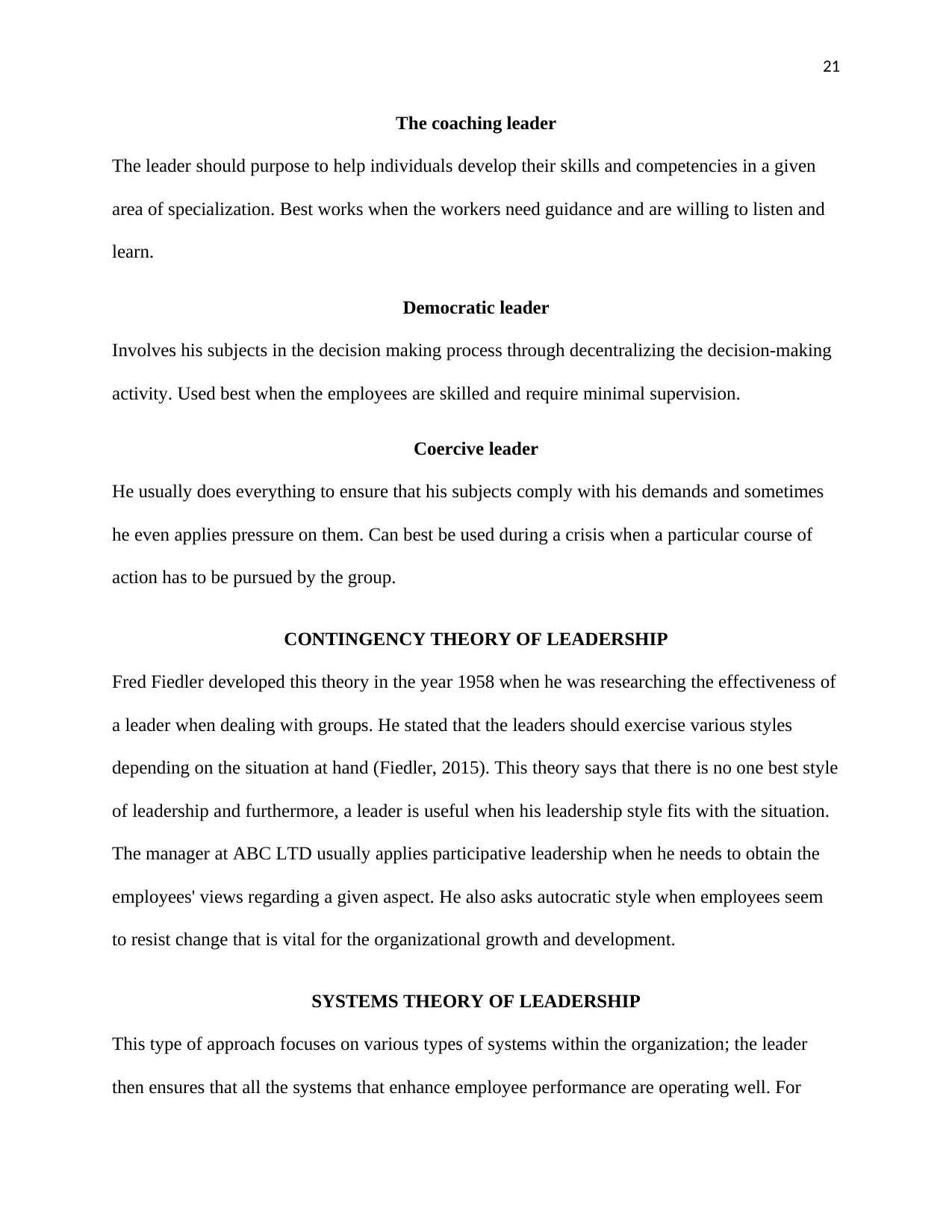
21
The coaching leader
The leader should purpose to help individuals develop their skills and competencies in a given
area of specialization. Best works when the workers need guidance and are willing to listen and
learn.
Democratic leader
Involves his subjects in the decision making process through decentralizing the decision-making
activity. Used best when the employees are skilled and require minimal supervision.
Coercive leader
He usually does everything to ensure that his subjects comply with his demands and sometimes
he even applies pressure on them. Can best be used during a crisis when a particular course of
action has to be pursued by the group.
CONTINGENCY THEORY OF LEADERSHIP
Fred Fiedler developed this theory in the year 1958 when he was researching the effectiveness of
a leader when dealing with groups. He stated that the leaders should exercise various styles
depending on the situation at hand (Fiedler, 2015). This theory says that there is no one best style
of leadership and furthermore, a leader is useful when his leadership style fits with the situation.
The manager at ABC LTD usually applies participative leadership when he needs to obtain the
employees' views regarding a given aspect. He also asks autocratic style when employees seem
to resist change that is vital for the organizational growth and development.
SYSTEMS THEORY OF LEADERSHIP
This type of approach focuses on various types of systems within the organization; the leader
then ensures that all the systems that enhance employee performance are operating well. For
The coaching leader
The leader should purpose to help individuals develop their skills and competencies in a given
area of specialization. Best works when the workers need guidance and are willing to listen and
learn.
Democratic leader
Involves his subjects in the decision making process through decentralizing the decision-making
activity. Used best when the employees are skilled and require minimal supervision.
Coercive leader
He usually does everything to ensure that his subjects comply with his demands and sometimes
he even applies pressure on them. Can best be used during a crisis when a particular course of
action has to be pursued by the group.
CONTINGENCY THEORY OF LEADERSHIP
Fred Fiedler developed this theory in the year 1958 when he was researching the effectiveness of
a leader when dealing with groups. He stated that the leaders should exercise various styles
depending on the situation at hand (Fiedler, 2015). This theory says that there is no one best style
of leadership and furthermore, a leader is useful when his leadership style fits with the situation.
The manager at ABC LTD usually applies participative leadership when he needs to obtain the
employees' views regarding a given aspect. He also asks autocratic style when employees seem
to resist change that is vital for the organizational growth and development.
SYSTEMS THEORY OF LEADERSHIP
This type of approach focuses on various types of systems within the organization; the leader
then ensures that all the systems that enhance employee performance are operating well. For
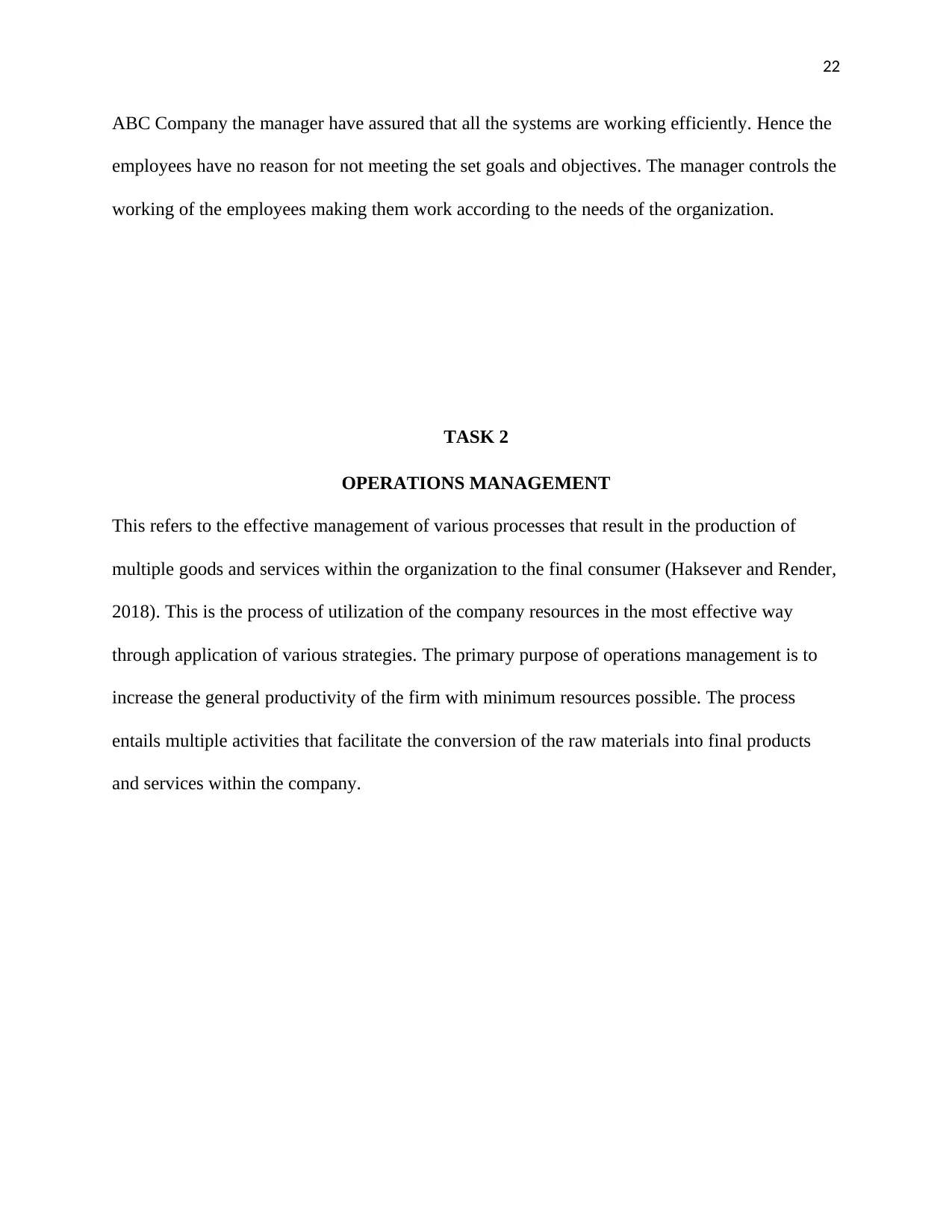
22
ABC Company the manager have assured that all the systems are working efficiently. Hence the
employees have no reason for not meeting the set goals and objectives. The manager controls the
working of the employees making them work according to the needs of the organization.
TASK 2
OPERATIONS MANAGEMENT
This refers to the effective management of various processes that result in the production of
multiple goods and services within the organization to the final consumer (Haksever and Render,
2018). This is the process of utilization of the company resources in the most effective way
through application of various strategies. The primary purpose of operations management is to
increase the general productivity of the firm with minimum resources possible. The process
entails multiple activities that facilitate the conversion of the raw materials into final products
and services within the company.
ABC Company the manager have assured that all the systems are working efficiently. Hence the
employees have no reason for not meeting the set goals and objectives. The manager controls the
working of the employees making them work according to the needs of the organization.
TASK 2
OPERATIONS MANAGEMENT
This refers to the effective management of various processes that result in the production of
multiple goods and services within the organization to the final consumer (Haksever and Render,
2018). This is the process of utilization of the company resources in the most effective way
through application of various strategies. The primary purpose of operations management is to
increase the general productivity of the firm with minimum resources possible. The process
entails multiple activities that facilitate the conversion of the raw materials into final products
and services within the company.
Secure Best Marks with AI Grader
Need help grading? Try our AI Grader for instant feedback on your assignments.
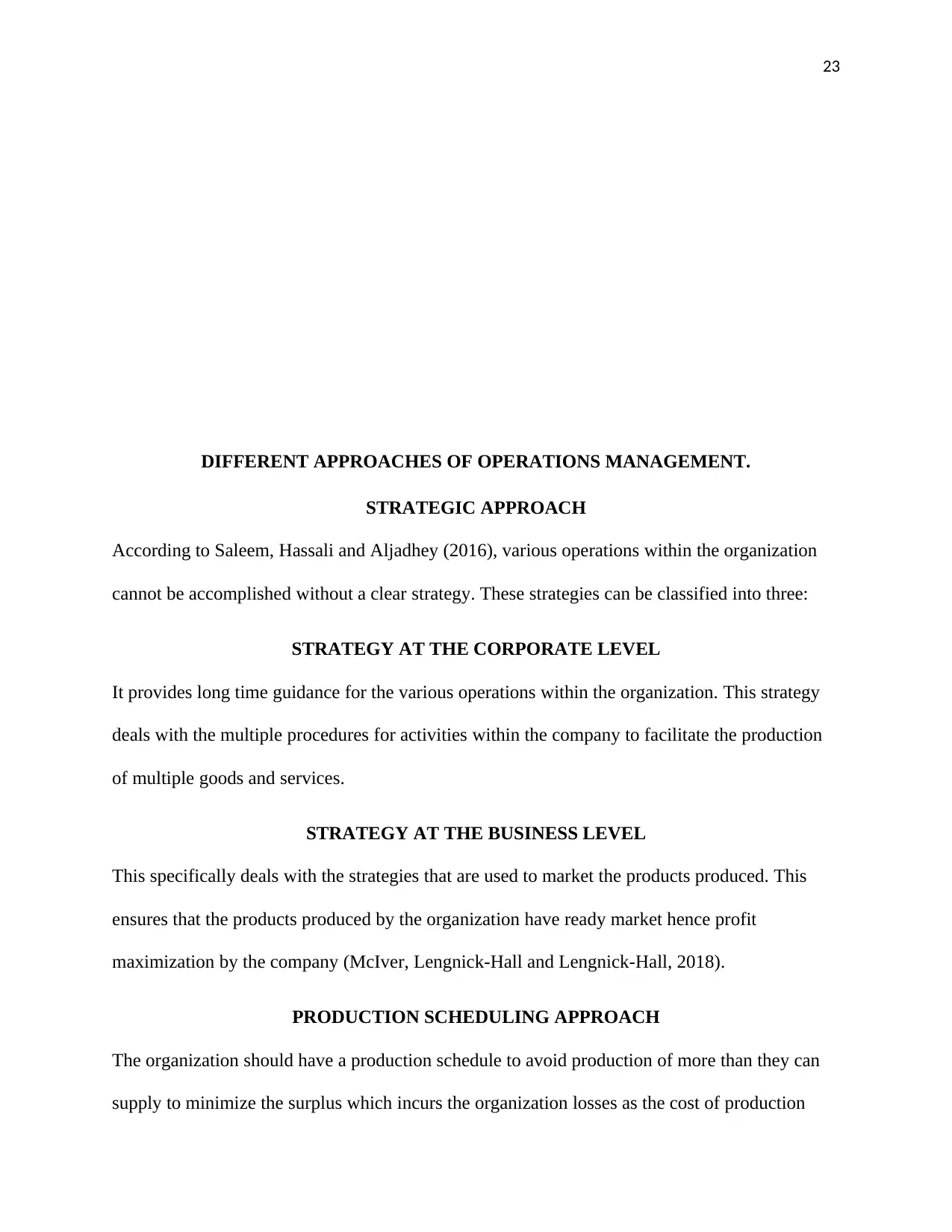
23
DIFFERENT APPROACHES OF OPERATIONS MANAGEMENT.
STRATEGIC APPROACH
According to Saleem, Hassali and Aljadhey (2016), various operations within the organization
cannot be accomplished without a clear strategy. These strategies can be classified into three:
STRATEGY AT THE CORPORATE LEVEL
It provides long time guidance for the various operations within the organization. This strategy
deals with the multiple procedures for activities within the company to facilitate the production
of multiple goods and services.
STRATEGY AT THE BUSINESS LEVEL
This specifically deals with the strategies that are used to market the products produced. This
ensures that the products produced by the organization have ready market hence profit
maximization by the company (McIver, Lengnick-Hall and Lengnick-Hall, 2018).
PRODUCTION SCHEDULING APPROACH
The organization should have a production schedule to avoid production of more than they can
supply to minimize the surplus which incurs the organization losses as the cost of production
DIFFERENT APPROACHES OF OPERATIONS MANAGEMENT.
STRATEGIC APPROACH
According to Saleem, Hassali and Aljadhey (2016), various operations within the organization
cannot be accomplished without a clear strategy. These strategies can be classified into three:
STRATEGY AT THE CORPORATE LEVEL
It provides long time guidance for the various operations within the organization. This strategy
deals with the multiple procedures for activities within the company to facilitate the production
of multiple goods and services.
STRATEGY AT THE BUSINESS LEVEL
This specifically deals with the strategies that are used to market the products produced. This
ensures that the products produced by the organization have ready market hence profit
maximization by the company (McIver, Lengnick-Hall and Lengnick-Hall, 2018).
PRODUCTION SCHEDULING APPROACH
The organization should have a production schedule to avoid production of more than they can
supply to minimize the surplus which incurs the organization losses as the cost of production
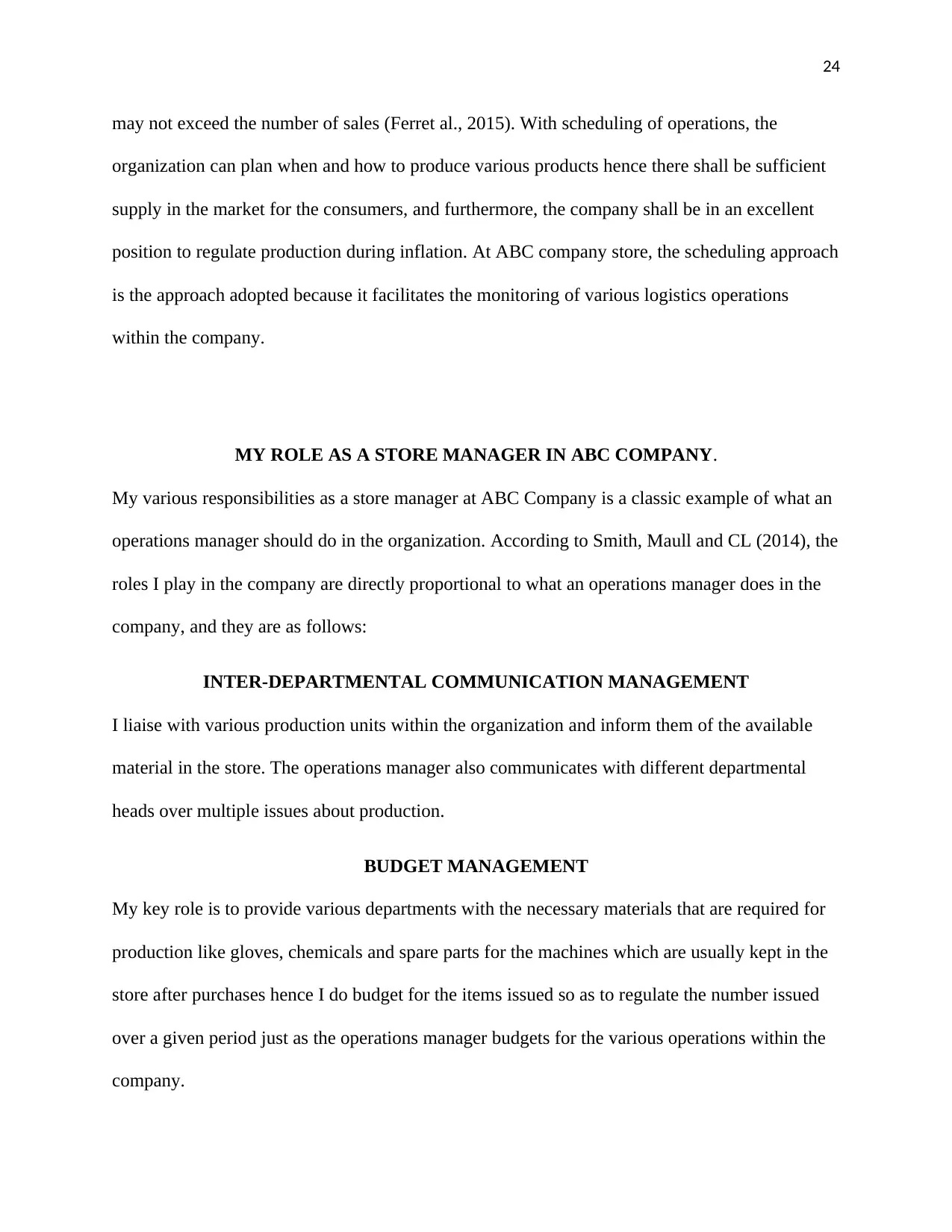
24
may not exceed the number of sales (Ferret al., 2015). With scheduling of operations, the
organization can plan when and how to produce various products hence there shall be sufficient
supply in the market for the consumers, and furthermore, the company shall be in an excellent
position to regulate production during inflation. At ABC company store, the scheduling approach
is the approach adopted because it facilitates the monitoring of various logistics operations
within the company.
MY ROLE AS A STORE MANAGER IN ABC COMPANY.
My various responsibilities as a store manager at ABC Company is a classic example of what an
operations manager should do in the organization. According to Smith, Maull and CL (2014), the
roles I play in the company are directly proportional to what an operations manager does in the
company, and they are as follows:
INTER-DEPARTMENTAL COMMUNICATION MANAGEMENT
I liaise with various production units within the organization and inform them of the available
material in the store. The operations manager also communicates with different departmental
heads over multiple issues about production.
BUDGET MANAGEMENT
My key role is to provide various departments with the necessary materials that are required for
production like gloves, chemicals and spare parts for the machines which are usually kept in the
store after purchases hence I do budget for the items issued so as to regulate the number issued
over a given period just as the operations manager budgets for the various operations within the
company.
may not exceed the number of sales (Ferret al., 2015). With scheduling of operations, the
organization can plan when and how to produce various products hence there shall be sufficient
supply in the market for the consumers, and furthermore, the company shall be in an excellent
position to regulate production during inflation. At ABC company store, the scheduling approach
is the approach adopted because it facilitates the monitoring of various logistics operations
within the company.
MY ROLE AS A STORE MANAGER IN ABC COMPANY.
My various responsibilities as a store manager at ABC Company is a classic example of what an
operations manager should do in the organization. According to Smith, Maull and CL (2014), the
roles I play in the company are directly proportional to what an operations manager does in the
company, and they are as follows:
INTER-DEPARTMENTAL COMMUNICATION MANAGEMENT
I liaise with various production units within the organization and inform them of the available
material in the store. The operations manager also communicates with different departmental
heads over multiple issues about production.
BUDGET MANAGEMENT
My key role is to provide various departments with the necessary materials that are required for
production like gloves, chemicals and spare parts for the machines which are usually kept in the
store after purchases hence I do budget for the items issued so as to regulate the number issued
over a given period just as the operations manager budgets for the various operations within the
company.
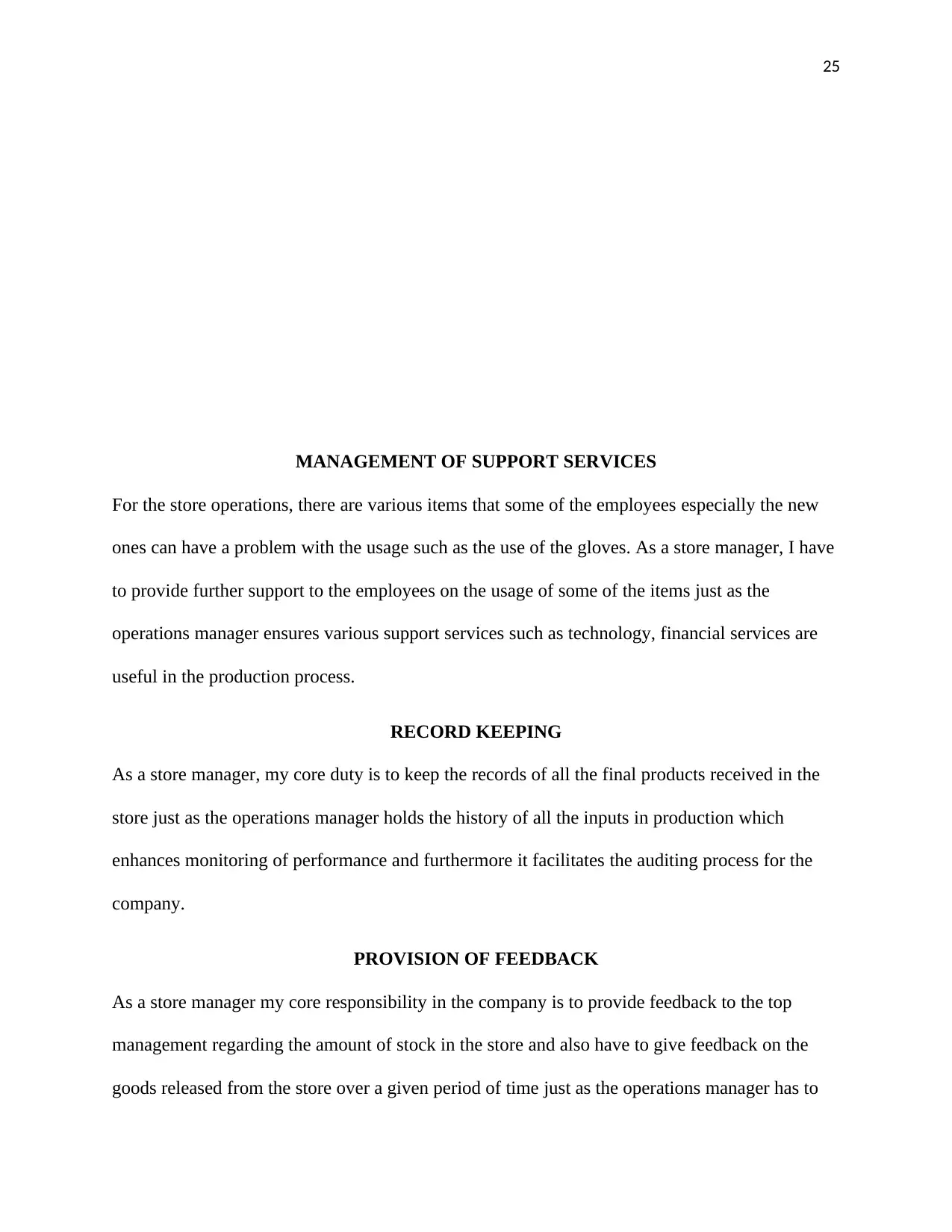
25
MANAGEMENT OF SUPPORT SERVICES
For the store operations, there are various items that some of the employees especially the new
ones can have a problem with the usage such as the use of the gloves. As a store manager, I have
to provide further support to the employees on the usage of some of the items just as the
operations manager ensures various support services such as technology, financial services are
useful in the production process.
RECORD KEEPING
As a store manager, my core duty is to keep the records of all the final products received in the
store just as the operations manager holds the history of all the inputs in production which
enhances monitoring of performance and furthermore it facilitates the auditing process for the
company.
PROVISION OF FEEDBACK
As a store manager my core responsibility in the company is to provide feedback to the top
management regarding the amount of stock in the store and also have to give feedback on the
goods released from the store over a given period of time just as the operations manager has to
MANAGEMENT OF SUPPORT SERVICES
For the store operations, there are various items that some of the employees especially the new
ones can have a problem with the usage such as the use of the gloves. As a store manager, I have
to provide further support to the employees on the usage of some of the items just as the
operations manager ensures various support services such as technology, financial services are
useful in the production process.
RECORD KEEPING
As a store manager, my core duty is to keep the records of all the final products received in the
store just as the operations manager holds the history of all the inputs in production which
enhances monitoring of performance and furthermore it facilitates the auditing process for the
company.
PROVISION OF FEEDBACK
As a store manager my core responsibility in the company is to provide feedback to the top
management regarding the amount of stock in the store and also have to give feedback on the
goods released from the store over a given period of time just as the operations manager has to
Paraphrase This Document
Need a fresh take? Get an instant paraphrase of this document with our AI Paraphraser
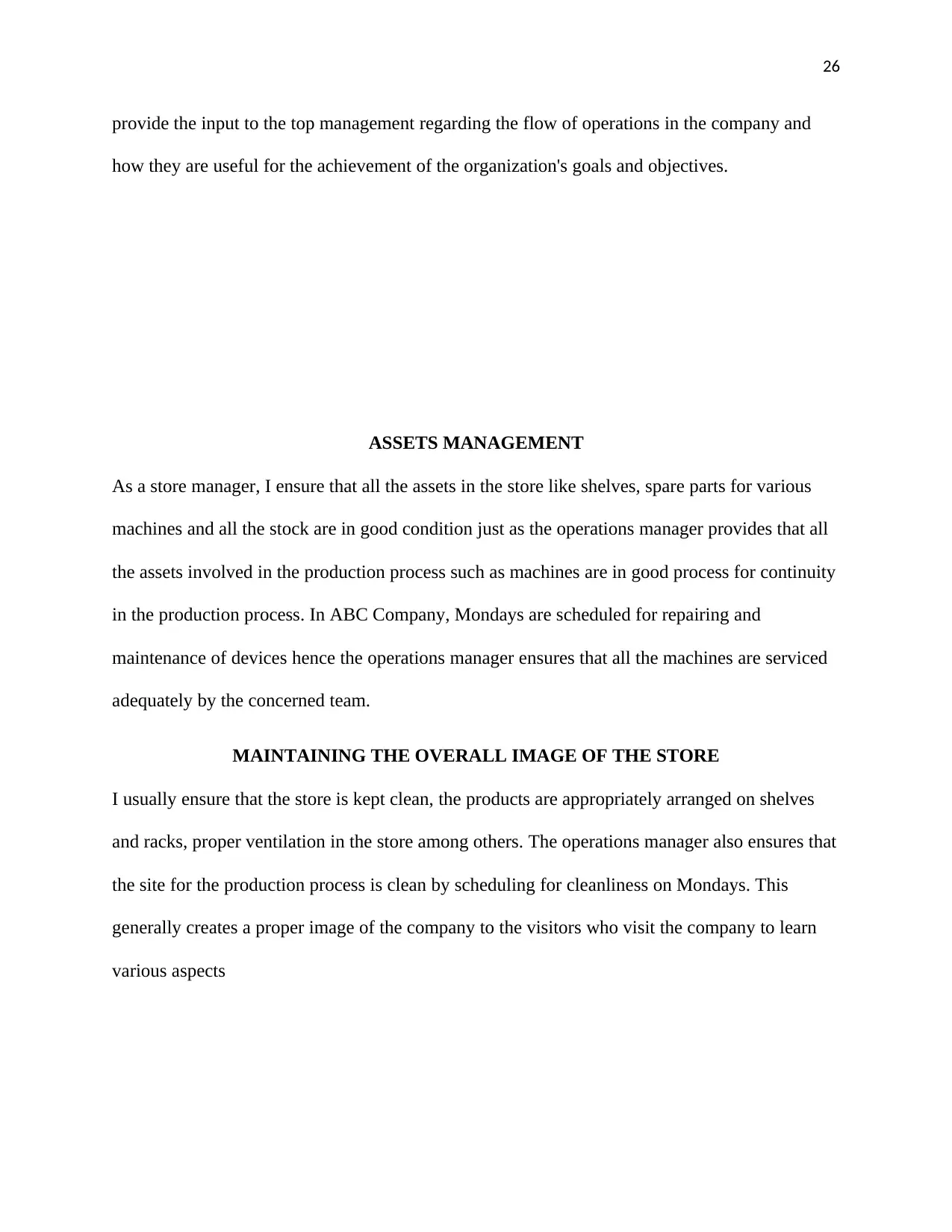
26
provide the input to the top management regarding the flow of operations in the company and
how they are useful for the achievement of the organization's goals and objectives.
ASSETS MANAGEMENT
As a store manager, I ensure that all the assets in the store like shelves, spare parts for various
machines and all the stock are in good condition just as the operations manager provides that all
the assets involved in the production process such as machines are in good process for continuity
in the production process. In ABC Company, Mondays are scheduled for repairing and
maintenance of devices hence the operations manager ensures that all the machines are serviced
adequately by the concerned team.
MAINTAINING THE OVERALL IMAGE OF THE STORE
I usually ensure that the store is kept clean, the products are appropriately arranged on shelves
and racks, proper ventilation in the store among others. The operations manager also ensures that
the site for the production process is clean by scheduling for cleanliness on Mondays. This
generally creates a proper image of the company to the visitors who visit the company to learn
various aspects
provide the input to the top management regarding the flow of operations in the company and
how they are useful for the achievement of the organization's goals and objectives.
ASSETS MANAGEMENT
As a store manager, I ensure that all the assets in the store like shelves, spare parts for various
machines and all the stock are in good condition just as the operations manager provides that all
the assets involved in the production process such as machines are in good process for continuity
in the production process. In ABC Company, Mondays are scheduled for repairing and
maintenance of devices hence the operations manager ensures that all the machines are serviced
adequately by the concerned team.
MAINTAINING THE OVERALL IMAGE OF THE STORE
I usually ensure that the store is kept clean, the products are appropriately arranged on shelves
and racks, proper ventilation in the store among others. The operations manager also ensures that
the site for the production process is clean by scheduling for cleanliness on Mondays. This
generally creates a proper image of the company to the visitors who visit the company to learn
various aspects
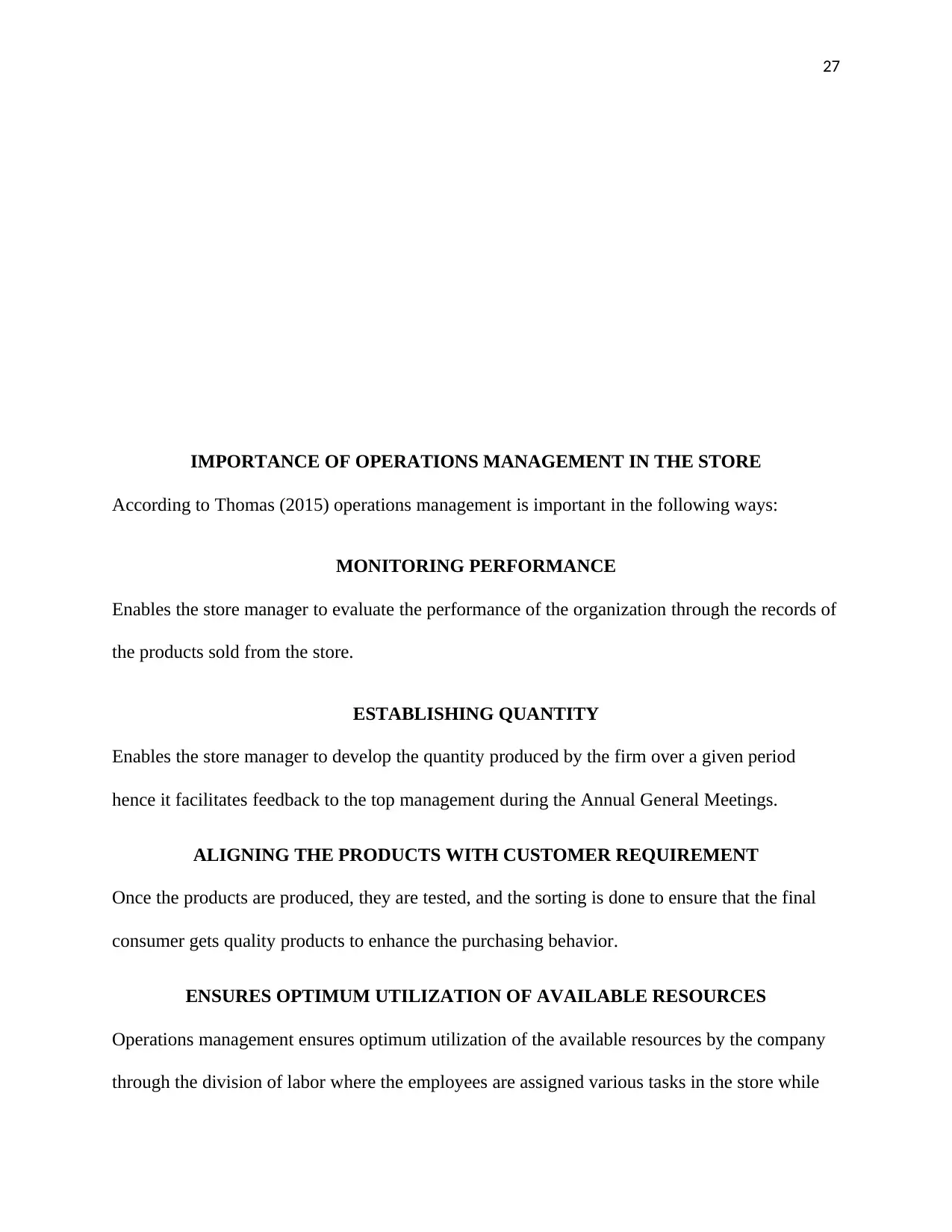
27
IMPORTANCE OF OPERATIONS MANAGEMENT IN THE STORE
According to Thomas (2015) operations management is important in the following ways:
MONITORING PERFORMANCE
Enables the store manager to evaluate the performance of the organization through the records of
the products sold from the store.
ESTABLISHING QUANTITY
Enables the store manager to develop the quantity produced by the firm over a given period
hence it facilitates feedback to the top management during the Annual General Meetings.
ALIGNING THE PRODUCTS WITH CUSTOMER REQUIREMENT
Once the products are produced, they are tested, and the sorting is done to ensure that the final
consumer gets quality products to enhance the purchasing behavior.
ENSURES OPTIMUM UTILIZATION OF AVAILABLE RESOURCES
Operations management ensures optimum utilization of the available resources by the company
through the division of labor where the employees are assigned various tasks in the store while
IMPORTANCE OF OPERATIONS MANAGEMENT IN THE STORE
According to Thomas (2015) operations management is important in the following ways:
MONITORING PERFORMANCE
Enables the store manager to evaluate the performance of the organization through the records of
the products sold from the store.
ESTABLISHING QUANTITY
Enables the store manager to develop the quantity produced by the firm over a given period
hence it facilitates feedback to the top management during the Annual General Meetings.
ALIGNING THE PRODUCTS WITH CUSTOMER REQUIREMENT
Once the products are produced, they are tested, and the sorting is done to ensure that the final
consumer gets quality products to enhance the purchasing behavior.
ENSURES OPTIMUM UTILIZATION OF AVAILABLE RESOURCES
Operations management ensures optimum utilization of the available resources by the company
through the division of labor where the employees are assigned various tasks in the store while
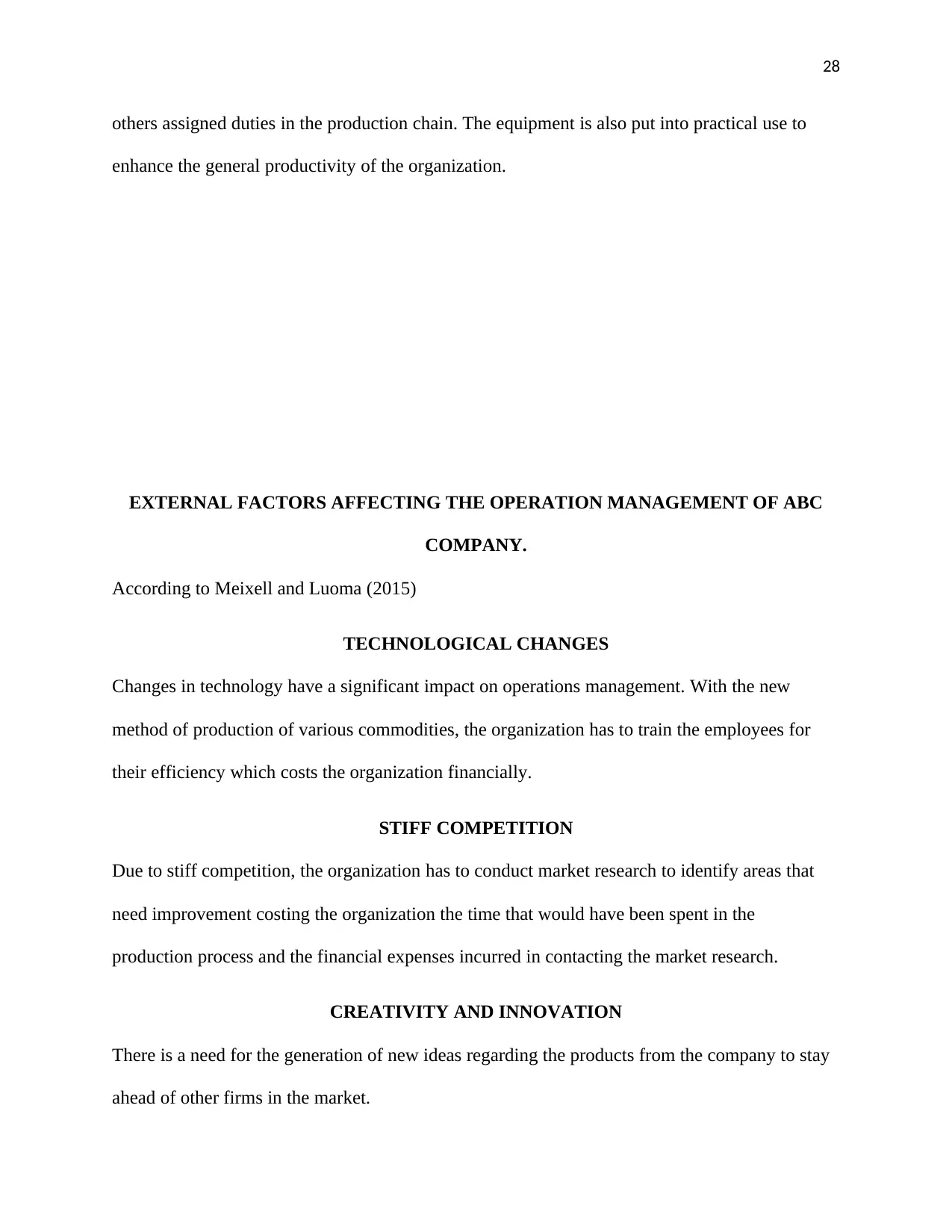
28
others assigned duties in the production chain. The equipment is also put into practical use to
enhance the general productivity of the organization.
EXTERNAL FACTORS AFFECTING THE OPERATION MANAGEMENT OF ABC
COMPANY.
According to Meixell and Luoma (2015)
TECHNOLOGICAL CHANGES
Changes in technology have a significant impact on operations management. With the new
method of production of various commodities, the organization has to train the employees for
their efficiency which costs the organization financially.
STIFF COMPETITION
Due to stiff competition, the organization has to conduct market research to identify areas that
need improvement costing the organization the time that would have been spent in the
production process and the financial expenses incurred in contacting the market research.
CREATIVITY AND INNOVATION
There is a need for the generation of new ideas regarding the products from the company to stay
ahead of other firms in the market.
others assigned duties in the production chain. The equipment is also put into practical use to
enhance the general productivity of the organization.
EXTERNAL FACTORS AFFECTING THE OPERATION MANAGEMENT OF ABC
COMPANY.
According to Meixell and Luoma (2015)
TECHNOLOGICAL CHANGES
Changes in technology have a significant impact on operations management. With the new
method of production of various commodities, the organization has to train the employees for
their efficiency which costs the organization financially.
STIFF COMPETITION
Due to stiff competition, the organization has to conduct market research to identify areas that
need improvement costing the organization the time that would have been spent in the
production process and the financial expenses incurred in contacting the market research.
CREATIVITY AND INNOVATION
There is a need for the generation of new ideas regarding the products from the company to stay
ahead of other firms in the market.
Secure Best Marks with AI Grader
Need help grading? Try our AI Grader for instant feedback on your assignments.
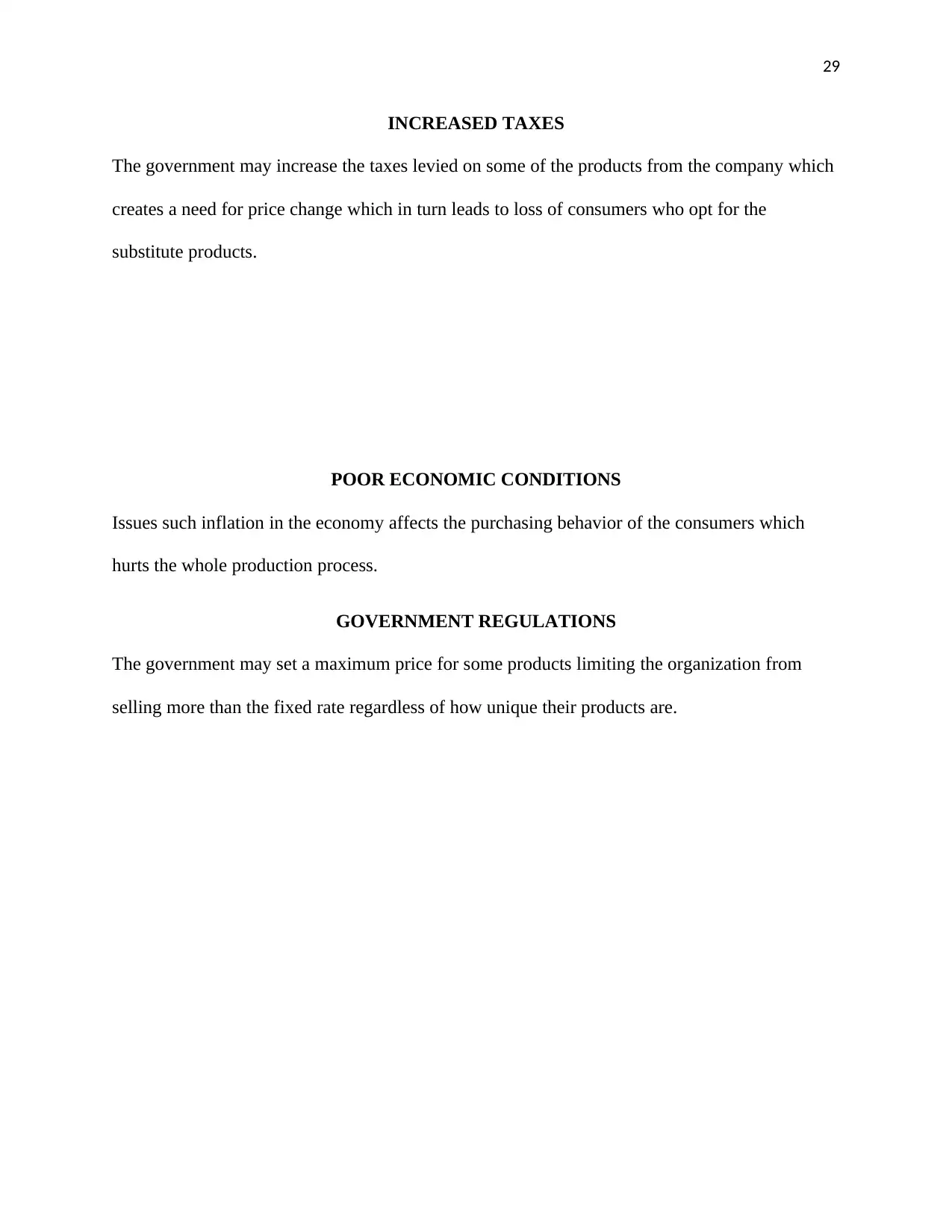
29
INCREASED TAXES
The government may increase the taxes levied on some of the products from the company which
creates a need for price change which in turn leads to loss of consumers who opt for the
substitute products.
POOR ECONOMIC CONDITIONS
Issues such inflation in the economy affects the purchasing behavior of the consumers which
hurts the whole production process.
GOVERNMENT REGULATIONS
The government may set a maximum price for some products limiting the organization from
selling more than the fixed rate regardless of how unique their products are.
INCREASED TAXES
The government may increase the taxes levied on some of the products from the company which
creates a need for price change which in turn leads to loss of consumers who opt for the
substitute products.
POOR ECONOMIC CONDITIONS
Issues such inflation in the economy affects the purchasing behavior of the consumers which
hurts the whole production process.
GOVERNMENT REGULATIONS
The government may set a maximum price for some products limiting the organization from
selling more than the fixed rate regardless of how unique their products are.
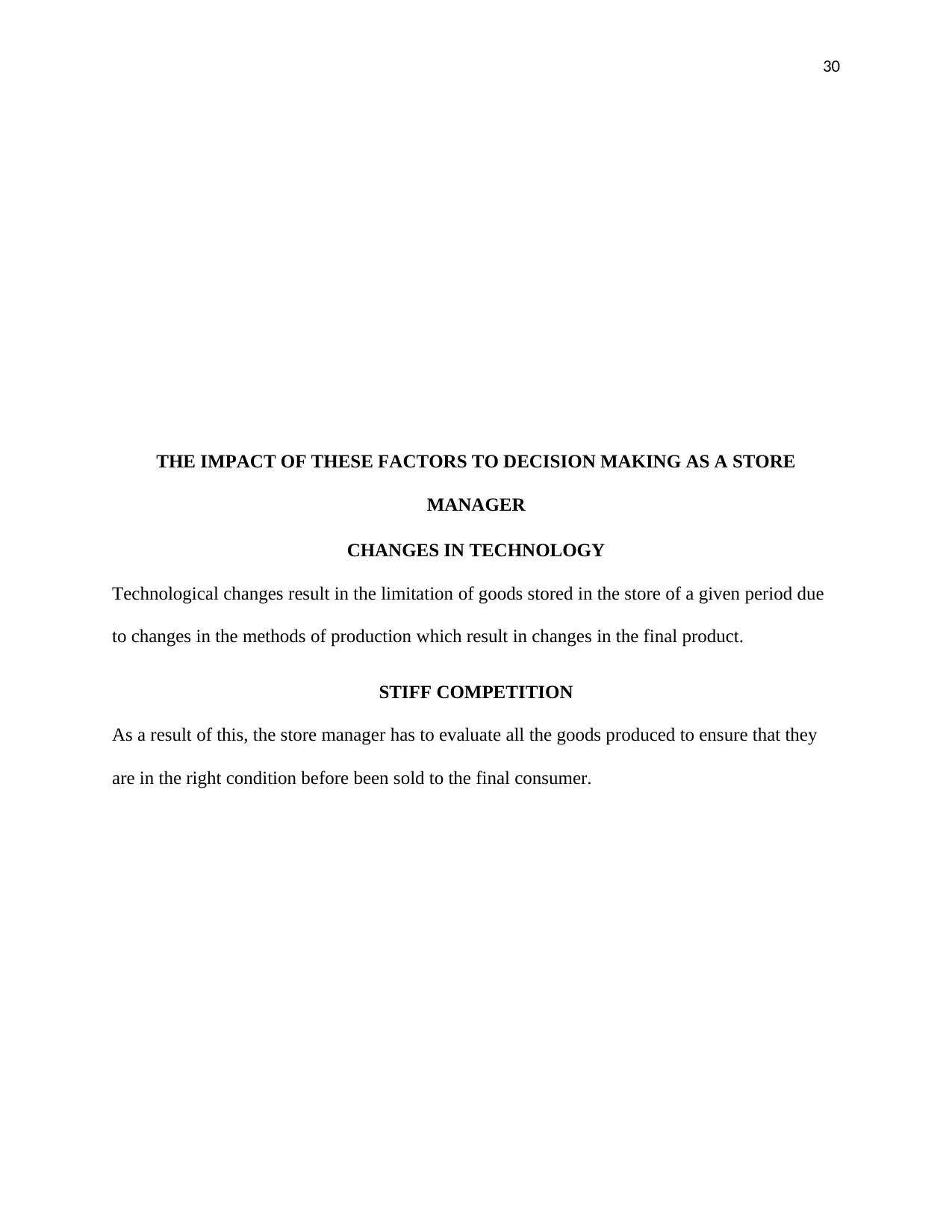
30
THE IMPACT OF THESE FACTORS TO DECISION MAKING AS A STORE
MANAGER
CHANGES IN TECHNOLOGY
Technological changes result in the limitation of goods stored in the store of a given period due
to changes in the methods of production which result in changes in the final product.
STIFF COMPETITION
As a result of this, the store manager has to evaluate all the goods produced to ensure that they
are in the right condition before been sold to the final consumer.
THE IMPACT OF THESE FACTORS TO DECISION MAKING AS A STORE
MANAGER
CHANGES IN TECHNOLOGY
Technological changes result in the limitation of goods stored in the store of a given period due
to changes in the methods of production which result in changes in the final product.
STIFF COMPETITION
As a result of this, the store manager has to evaluate all the goods produced to ensure that they
are in the right condition before been sold to the final consumer.
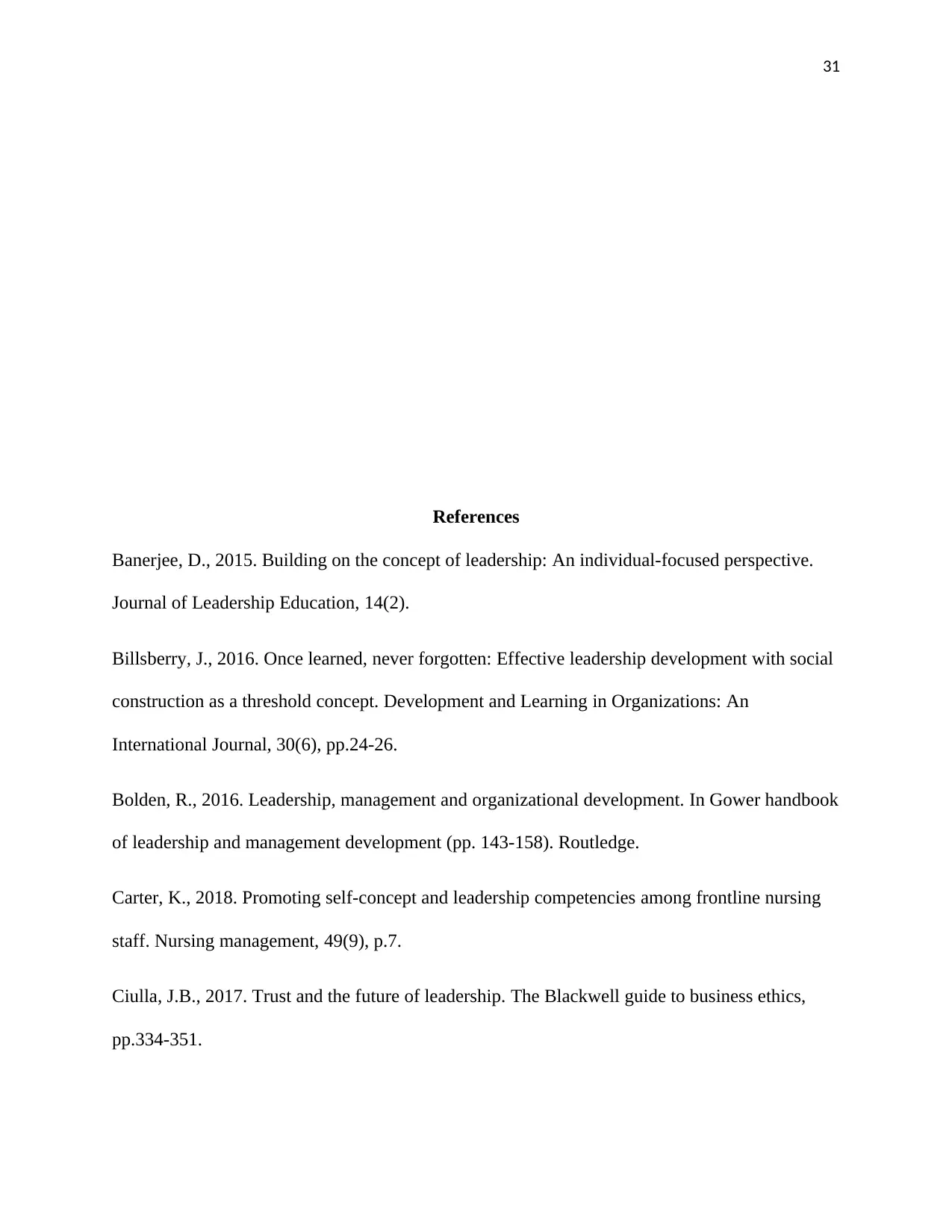
31
References
Banerjee, D., 2015. Building on the concept of leadership: An individual-focused perspective.
Journal of Leadership Education, 14(2).
Billsberry, J., 2016. Once learned, never forgotten: Effective leadership development with social
construction as a threshold concept. Development and Learning in Organizations: An
International Journal, 30(6), pp.24-26.
Bolden, R., 2016. Leadership, management and organizational development. In Gower handbook
of leadership and management development (pp. 143-158). Routledge.
Carter, K., 2018. Promoting self-concept and leadership competencies among frontline nursing
staff. Nursing management, 49(9), p.7.
Ciulla, J.B., 2017. Trust and the future of leadership. The Blackwell guide to business ethics,
pp.334-351.
References
Banerjee, D., 2015. Building on the concept of leadership: An individual-focused perspective.
Journal of Leadership Education, 14(2).
Billsberry, J., 2016. Once learned, never forgotten: Effective leadership development with social
construction as a threshold concept. Development and Learning in Organizations: An
International Journal, 30(6), pp.24-26.
Bolden, R., 2016. Leadership, management and organizational development. In Gower handbook
of leadership and management development (pp. 143-158). Routledge.
Carter, K., 2018. Promoting self-concept and leadership competencies among frontline nursing
staff. Nursing management, 49(9), p.7.
Ciulla, J.B., 2017. Trust and the future of leadership. The Blackwell guide to business ethics,
pp.334-351.
Paraphrase This Document
Need a fresh take? Get an instant paraphrase of this document with our AI Paraphraser
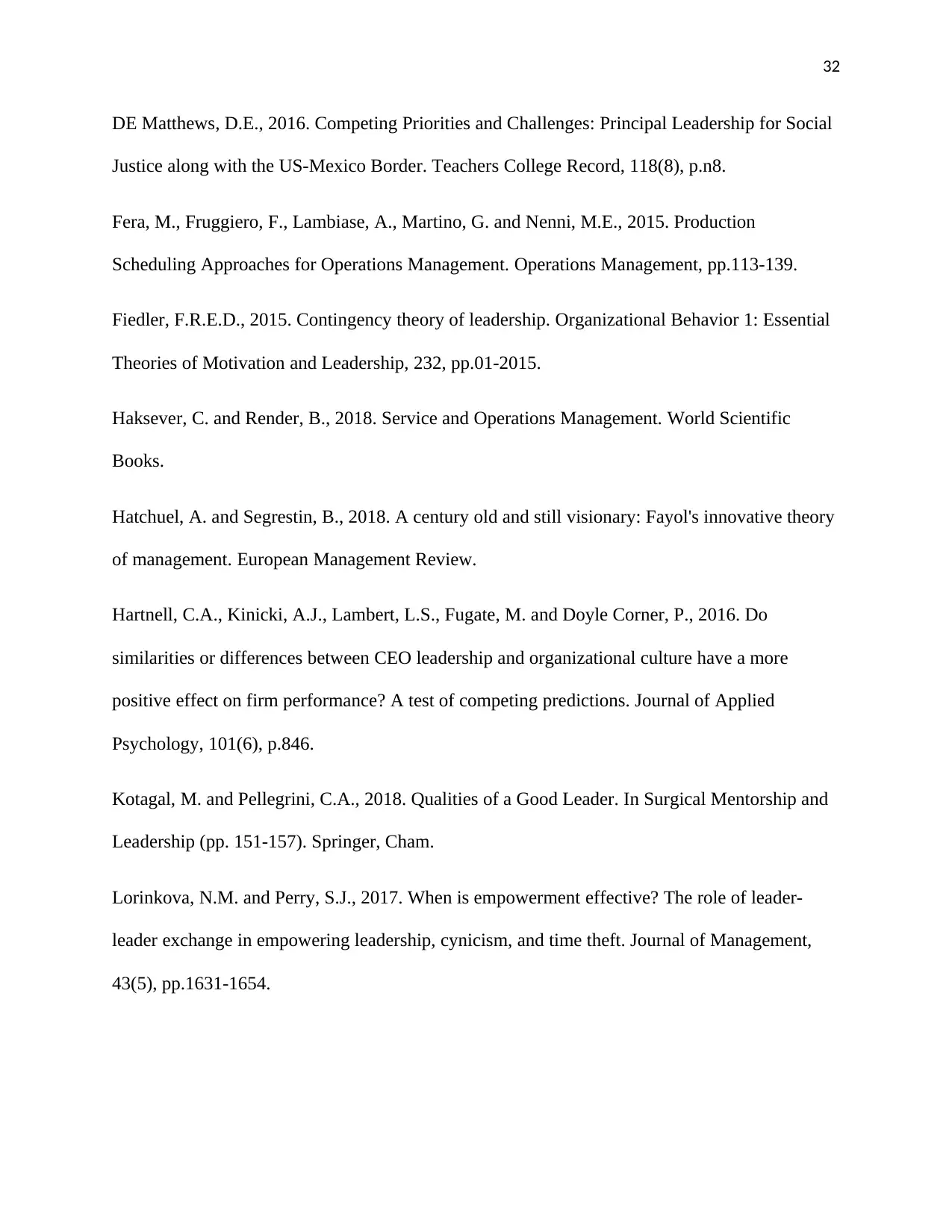
32
DE Matthews, D.E., 2016. Competing Priorities and Challenges: Principal Leadership for Social
Justice along with the US-Mexico Border. Teachers College Record, 118(8), p.n8.
Fera, M., Fruggiero, F., Lambiase, A., Martino, G. and Nenni, M.E., 2015. Production
Scheduling Approaches for Operations Management. Operations Management, pp.113-139.
Fiedler, F.R.E.D., 2015. Contingency theory of leadership. Organizational Behavior 1: Essential
Theories of Motivation and Leadership, 232, pp.01-2015.
Haksever, C. and Render, B., 2018. Service and Operations Management. World Scientific
Books.
Hatchuel, A. and Segrestin, B., 2018. A century old and still visionary: Fayol's innovative theory
of management. European Management Review.
Hartnell, C.A., Kinicki, A.J., Lambert, L.S., Fugate, M. and Doyle Corner, P., 2016. Do
similarities or differences between CEO leadership and organizational culture have a more
positive effect on firm performance? A test of competing predictions. Journal of Applied
Psychology, 101(6), p.846.
Kotagal, M. and Pellegrini, C.A., 2018. Qualities of a Good Leader. In Surgical Mentorship and
Leadership (pp. 151-157). Springer, Cham.
Lorinkova, N.M. and Perry, S.J., 2017. When is empowerment effective? The role of leader-
leader exchange in empowering leadership, cynicism, and time theft. Journal of Management,
43(5), pp.1631-1654.
DE Matthews, D.E., 2016. Competing Priorities and Challenges: Principal Leadership for Social
Justice along with the US-Mexico Border. Teachers College Record, 118(8), p.n8.
Fera, M., Fruggiero, F., Lambiase, A., Martino, G. and Nenni, M.E., 2015. Production
Scheduling Approaches for Operations Management. Operations Management, pp.113-139.
Fiedler, F.R.E.D., 2015. Contingency theory of leadership. Organizational Behavior 1: Essential
Theories of Motivation and Leadership, 232, pp.01-2015.
Haksever, C. and Render, B., 2018. Service and Operations Management. World Scientific
Books.
Hatchuel, A. and Segrestin, B., 2018. A century old and still visionary: Fayol's innovative theory
of management. European Management Review.
Hartnell, C.A., Kinicki, A.J., Lambert, L.S., Fugate, M. and Doyle Corner, P., 2016. Do
similarities or differences between CEO leadership and organizational culture have a more
positive effect on firm performance? A test of competing predictions. Journal of Applied
Psychology, 101(6), p.846.
Kotagal, M. and Pellegrini, C.A., 2018. Qualities of a Good Leader. In Surgical Mentorship and
Leadership (pp. 151-157). Springer, Cham.
Lorinkova, N.M. and Perry, S.J., 2017. When is empowerment effective? The role of leader-
leader exchange in empowering leadership, cynicism, and time theft. Journal of Management,
43(5), pp.1631-1654.
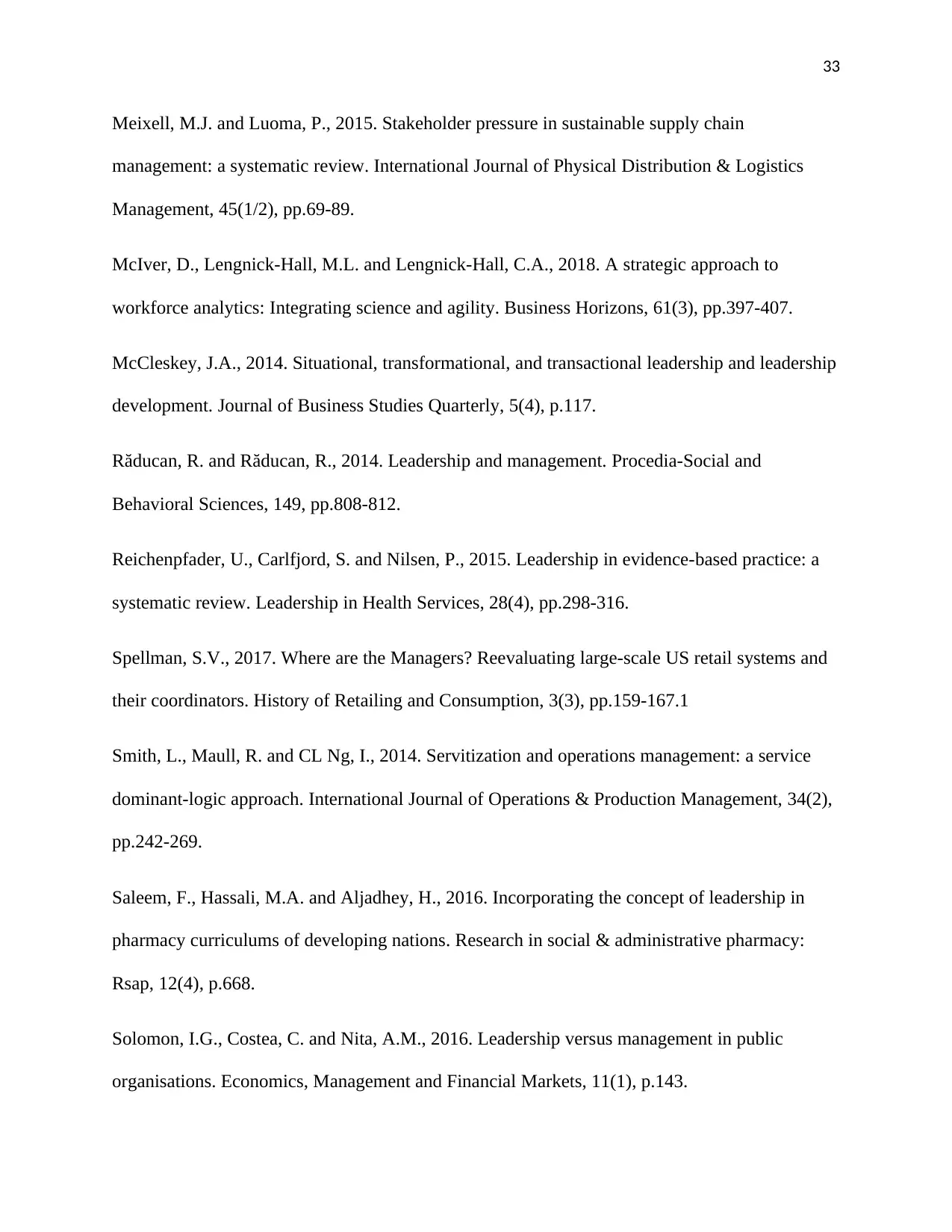
33
Meixell, M.J. and Luoma, P., 2015. Stakeholder pressure in sustainable supply chain
management: a systematic review. International Journal of Physical Distribution & Logistics
Management, 45(1/2), pp.69-89.
McIver, D., Lengnick-Hall, M.L. and Lengnick-Hall, C.A., 2018. A strategic approach to
workforce analytics: Integrating science and agility. Business Horizons, 61(3), pp.397-407.
McCleskey, J.A., 2014. Situational, transformational, and transactional leadership and leadership
development. Journal of Business Studies Quarterly, 5(4), p.117.
Răducan, R. and Răducan, R., 2014. Leadership and management. Procedia-Social and
Behavioral Sciences, 149, pp.808-812.
Reichenpfader, U., Carlfjord, S. and Nilsen, P., 2015. Leadership in evidence-based practice: a
systematic review. Leadership in Health Services, 28(4), pp.298-316.
Spellman, S.V., 2017. Where are the Managers? Reevaluating large-scale US retail systems and
their coordinators. History of Retailing and Consumption, 3(3), pp.159-167.1
Smith, L., Maull, R. and CL Ng, I., 2014. Servitization and operations management: a service
dominant-logic approach. International Journal of Operations & Production Management, 34(2),
pp.242-269.
Saleem, F., Hassali, M.A. and Aljadhey, H., 2016. Incorporating the concept of leadership in
pharmacy curriculums of developing nations. Research in social & administrative pharmacy:
Rsap, 12(4), p.668.
Solomon, I.G., Costea, C. and Nita, A.M., 2016. Leadership versus management in public
organisations. Economics, Management and Financial Markets, 11(1), p.143.
Meixell, M.J. and Luoma, P., 2015. Stakeholder pressure in sustainable supply chain
management: a systematic review. International Journal of Physical Distribution & Logistics
Management, 45(1/2), pp.69-89.
McIver, D., Lengnick-Hall, M.L. and Lengnick-Hall, C.A., 2018. A strategic approach to
workforce analytics: Integrating science and agility. Business Horizons, 61(3), pp.397-407.
McCleskey, J.A., 2014. Situational, transformational, and transactional leadership and leadership
development. Journal of Business Studies Quarterly, 5(4), p.117.
Răducan, R. and Răducan, R., 2014. Leadership and management. Procedia-Social and
Behavioral Sciences, 149, pp.808-812.
Reichenpfader, U., Carlfjord, S. and Nilsen, P., 2015. Leadership in evidence-based practice: a
systematic review. Leadership in Health Services, 28(4), pp.298-316.
Spellman, S.V., 2017. Where are the Managers? Reevaluating large-scale US retail systems and
their coordinators. History of Retailing and Consumption, 3(3), pp.159-167.1
Smith, L., Maull, R. and CL Ng, I., 2014. Servitization and operations management: a service
dominant-logic approach. International Journal of Operations & Production Management, 34(2),
pp.242-269.
Saleem, F., Hassali, M.A. and Aljadhey, H., 2016. Incorporating the concept of leadership in
pharmacy curriculums of developing nations. Research in social & administrative pharmacy:
Rsap, 12(4), p.668.
Solomon, I.G., Costea, C. and Nita, A.M., 2016. Leadership versus management in public
organisations. Economics, Management and Financial Markets, 11(1), p.143.
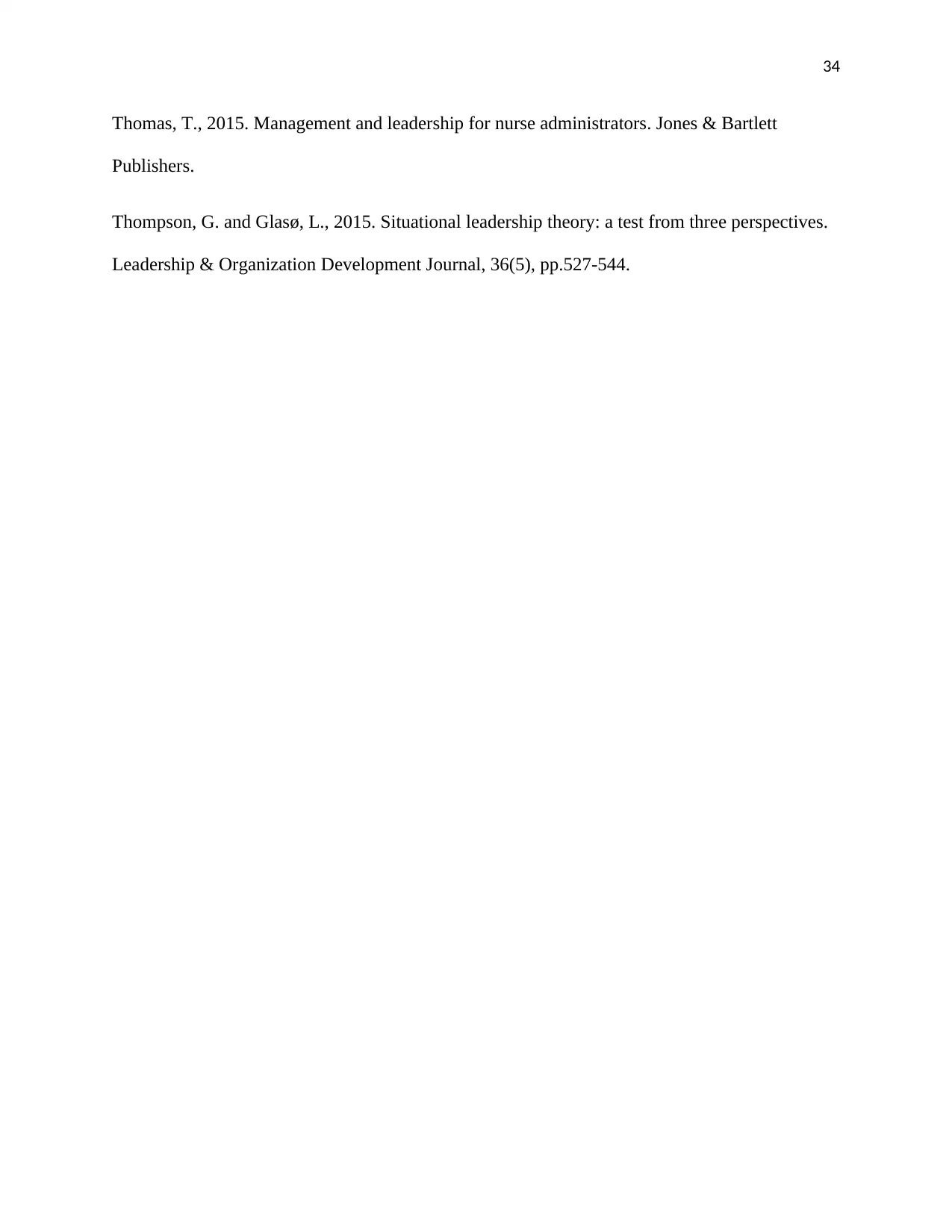
34
Thomas, T., 2015. Management and leadership for nurse administrators. Jones & Bartlett
Publishers.
Thompson, G. and Glasø, L., 2015. Situational leadership theory: a test from three perspectives.
Leadership & Organization Development Journal, 36(5), pp.527-544.
Thomas, T., 2015. Management and leadership for nurse administrators. Jones & Bartlett
Publishers.
Thompson, G. and Glasø, L., 2015. Situational leadership theory: a test from three perspectives.
Leadership & Organization Development Journal, 36(5), pp.527-544.
1 out of 34
Related Documents
Your All-in-One AI-Powered Toolkit for Academic Success.
+13062052269
info@desklib.com
Available 24*7 on WhatsApp / Email
![[object Object]](/_next/static/media/star-bottom.7253800d.svg)
Unlock your academic potential
© 2024 | Zucol Services PVT LTD | All rights reserved.




